Development of an Information System for a Retail Organization
VerifiedAdded on 2022/11/29
|34
|5364
|188
AI Summary
This project discusses the development of an information system for a retail organization. It emphasizes the importance of such a system in ensuring a continuous flow of goods and services. The objectives include providing relevant information to the retail manager, anticipating the organization's needs, and adapting to changes in consumer demands. The critical success factors include system connectivity, product management, customer analysis, flexible pricing, and efficient communication. The recommended option is the implementation of the Retail Pro software. This system offers features such as sales and checkout criteria, customer preference understanding, payment options, and efficient inventory management. Read more on Desklib.
Contribute Materials
Your contribution can guide someone’s learning journey. Share your
documents today.
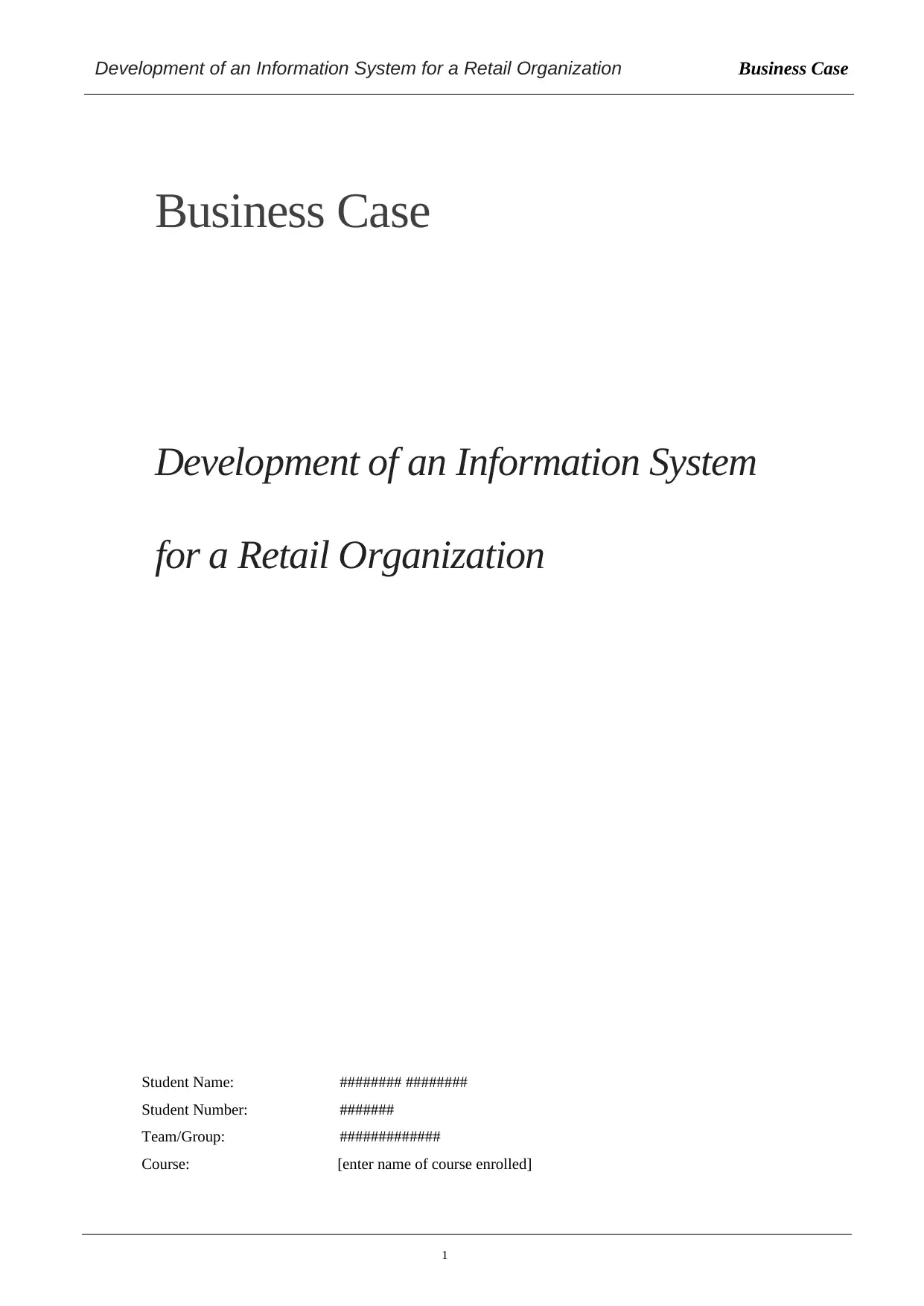
Development of an Information System for a Retail Organization Business Case
Business Case
Development of an Information System
for a Retail Organization
Student Name: ######## ########
Student Number: #######
Team/Group: #############
Course: [enter name of course enrolled]
1
Business Case
Development of an Information System
for a Retail Organization
Student Name: ######## ########
Student Number: #######
Team/Group: #############
Course: [enter name of course enrolled]
1
Secure Best Marks with AI Grader
Need help grading? Try our AI Grader for instant feedback on your assignments.

Development of an Information System for a Retail Organization Business Case
Unit Coordinator/
Lecturer: Grant Axman-Friend (g.axman-friend@qut.edu.au)
Institution: Queensland University of Technology
Teaching Period: [enter semester and year]
2
Unit Coordinator/
Lecturer: Grant Axman-Friend (g.axman-friend@qut.edu.au)
Institution: Queensland University of Technology
Teaching Period: [enter semester and year]
2

DOUBLE CLICK HERE TO ADD HEADER
EXECUTIVE SUMMARY
This project identifies the necessary measures that should be undertaken to ensure the
successful implementation of an information system in a retail company. Seeing that retail
companies are mandated with the responsibility of providing a continuous flow of goods and
services, the essay discusses the importance of such a system to the retail organization. In this
regard, the primary emphasis is what the project may mean to the whole company structure.
Other factors that have been discussed pertain the implementation of the system in a retail
organization and how the management may ensure that there is successful project
completion.
DOUBLE CLICK HERE TO ADD FOOTER
EXECUTIVE SUMMARY
This project identifies the necessary measures that should be undertaken to ensure the
successful implementation of an information system in a retail company. Seeing that retail
companies are mandated with the responsibility of providing a continuous flow of goods and
services, the essay discusses the importance of such a system to the retail organization. In this
regard, the primary emphasis is what the project may mean to the whole company structure.
Other factors that have been discussed pertain the implementation of the system in a retail
organization and how the management may ensure that there is successful project
completion.
DOUBLE CLICK HERE TO ADD FOOTER
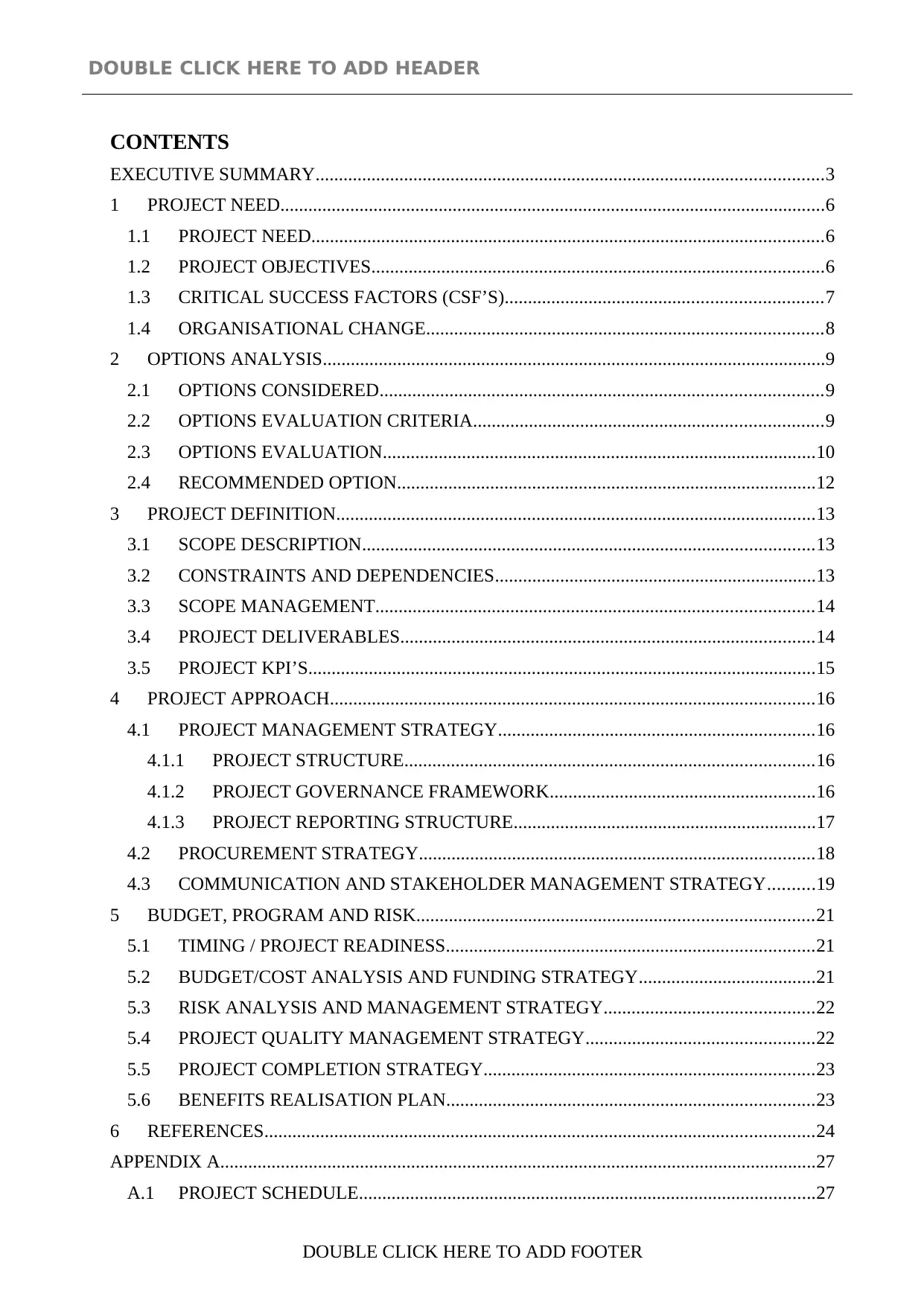
DOUBLE CLICK HERE TO ADD HEADER
CONTENTS
EXECUTIVE SUMMARY.............................................................................................................3
1 PROJECT NEED.....................................................................................................................6
1.1 PROJECT NEED..............................................................................................................6
1.2 PROJECT OBJECTIVES.................................................................................................6
1.3 CRITICAL SUCCESS FACTORS (CSF’S)....................................................................7
1.4 ORGANISATIONAL CHANGE.....................................................................................8
2 OPTIONS ANALYSIS............................................................................................................9
2.1 OPTIONS CONSIDERED...............................................................................................9
2.2 OPTIONS EVALUATION CRITERIA...........................................................................9
2.3 OPTIONS EVALUATION.............................................................................................10
2.4 RECOMMENDED OPTION..........................................................................................12
3 PROJECT DEFINITION.......................................................................................................13
3.1 SCOPE DESCRIPTION.................................................................................................13
3.2 CONSTRAINTS AND DEPENDENCIES.....................................................................13
3.3 SCOPE MANAGEMENT..............................................................................................14
3.4 PROJECT DELIVERABLES.........................................................................................14
3.5 PROJECT KPI’S.............................................................................................................15
4 PROJECT APPROACH........................................................................................................16
4.1 PROJECT MANAGEMENT STRATEGY....................................................................16
4.1.1 PROJECT STRUCTURE........................................................................................16
4.1.2 PROJECT GOVERNANCE FRAMEWORK.........................................................16
4.1.3 PROJECT REPORTING STRUCTURE.................................................................17
4.2 PROCUREMENT STRATEGY.....................................................................................18
4.3 COMMUNICATION AND STAKEHOLDER MANAGEMENT STRATEGY..........19
5 BUDGET, PROGRAM AND RISK.....................................................................................21
5.1 TIMING / PROJECT READINESS...............................................................................21
5.2 BUDGET/COST ANALYSIS AND FUNDING STRATEGY......................................21
5.3 RISK ANALYSIS AND MANAGEMENT STRATEGY.............................................22
5.4 PROJECT QUALITY MANAGEMENT STRATEGY.................................................22
5.5 PROJECT COMPLETION STRATEGY.......................................................................23
5.6 BENEFITS REALISATION PLAN...............................................................................23
6 REFERENCES......................................................................................................................24
APPENDIX A................................................................................................................................27
A.1 PROJECT SCHEDULE..................................................................................................27
DOUBLE CLICK HERE TO ADD FOOTER
CONTENTS
EXECUTIVE SUMMARY.............................................................................................................3
1 PROJECT NEED.....................................................................................................................6
1.1 PROJECT NEED..............................................................................................................6
1.2 PROJECT OBJECTIVES.................................................................................................6
1.3 CRITICAL SUCCESS FACTORS (CSF’S)....................................................................7
1.4 ORGANISATIONAL CHANGE.....................................................................................8
2 OPTIONS ANALYSIS............................................................................................................9
2.1 OPTIONS CONSIDERED...............................................................................................9
2.2 OPTIONS EVALUATION CRITERIA...........................................................................9
2.3 OPTIONS EVALUATION.............................................................................................10
2.4 RECOMMENDED OPTION..........................................................................................12
3 PROJECT DEFINITION.......................................................................................................13
3.1 SCOPE DESCRIPTION.................................................................................................13
3.2 CONSTRAINTS AND DEPENDENCIES.....................................................................13
3.3 SCOPE MANAGEMENT..............................................................................................14
3.4 PROJECT DELIVERABLES.........................................................................................14
3.5 PROJECT KPI’S.............................................................................................................15
4 PROJECT APPROACH........................................................................................................16
4.1 PROJECT MANAGEMENT STRATEGY....................................................................16
4.1.1 PROJECT STRUCTURE........................................................................................16
4.1.2 PROJECT GOVERNANCE FRAMEWORK.........................................................16
4.1.3 PROJECT REPORTING STRUCTURE.................................................................17
4.2 PROCUREMENT STRATEGY.....................................................................................18
4.3 COMMUNICATION AND STAKEHOLDER MANAGEMENT STRATEGY..........19
5 BUDGET, PROGRAM AND RISK.....................................................................................21
5.1 TIMING / PROJECT READINESS...............................................................................21
5.2 BUDGET/COST ANALYSIS AND FUNDING STRATEGY......................................21
5.3 RISK ANALYSIS AND MANAGEMENT STRATEGY.............................................22
5.4 PROJECT QUALITY MANAGEMENT STRATEGY.................................................22
5.5 PROJECT COMPLETION STRATEGY.......................................................................23
5.6 BENEFITS REALISATION PLAN...............................................................................23
6 REFERENCES......................................................................................................................24
APPENDIX A................................................................................................................................27
A.1 PROJECT SCHEDULE..................................................................................................27
DOUBLE CLICK HERE TO ADD FOOTER
Secure Best Marks with AI Grader
Need help grading? Try our AI Grader for instant feedback on your assignments.
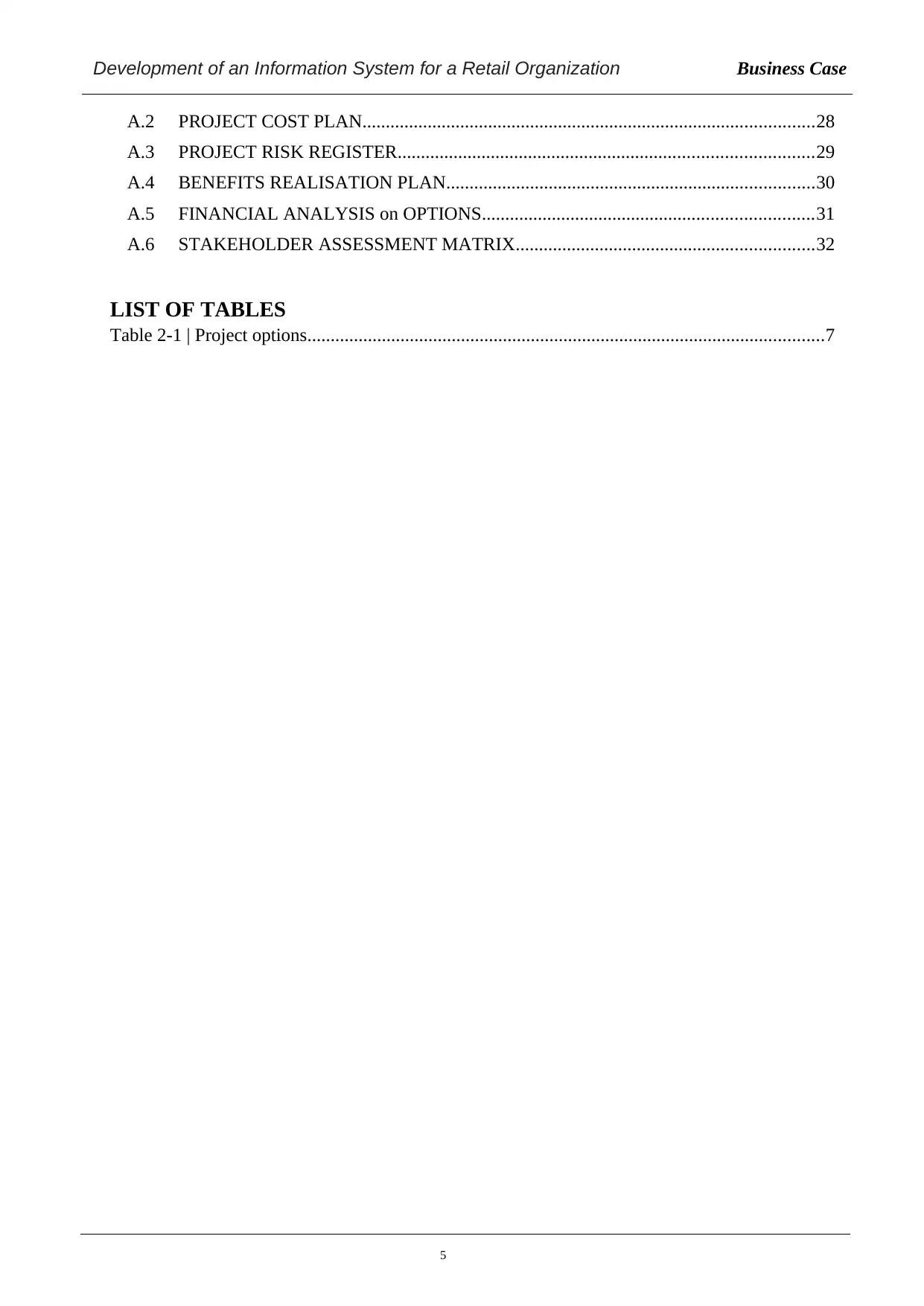
Development of an Information System for a Retail Organization Business Case
A.2 PROJECT COST PLAN.................................................................................................28
A.3 PROJECT RISK REGISTER.........................................................................................29
A.4 BENEFITS REALISATION PLAN...............................................................................30
A.5 FINANCIAL ANALYSIS on OPTIONS.......................................................................31
A.6 STAKEHOLDER ASSESSMENT MATRIX................................................................32
LIST OF TABLES
Table 2-1 | Project options...............................................................................................................7
5
A.2 PROJECT COST PLAN.................................................................................................28
A.3 PROJECT RISK REGISTER.........................................................................................29
A.4 BENEFITS REALISATION PLAN...............................................................................30
A.5 FINANCIAL ANALYSIS on OPTIONS.......................................................................31
A.6 STAKEHOLDER ASSESSMENT MATRIX................................................................32
LIST OF TABLES
Table 2-1 | Project options...............................................................................................................7
5
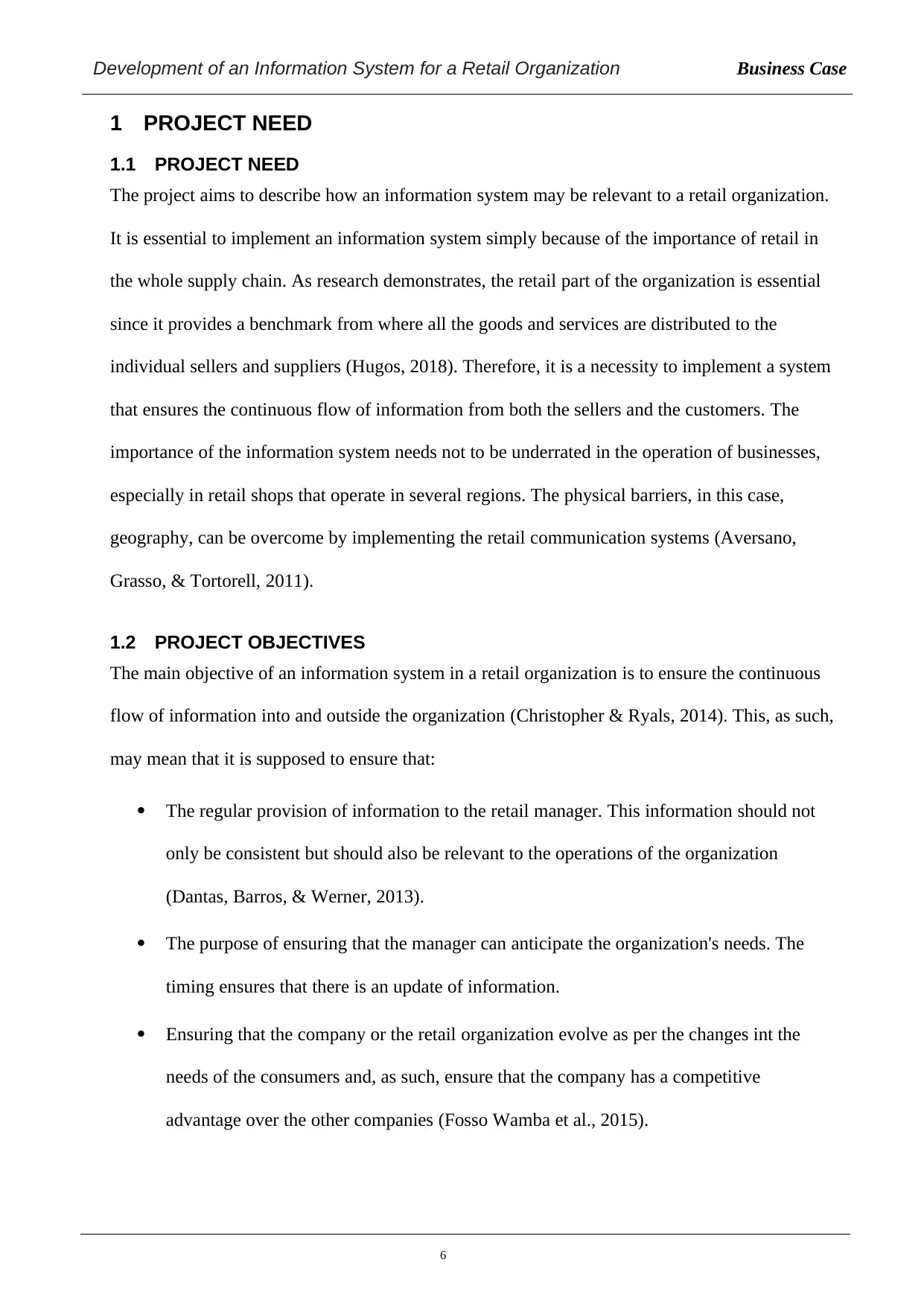
Development of an Information System for a Retail Organization Business Case
1 PROJECT NEED
1.1 PROJECT NEED
The project aims to describe how an information system may be relevant to a retail organization.
It is essential to implement an information system simply because of the importance of retail in
the whole supply chain. As research demonstrates, the retail part of the organization is essential
since it provides a benchmark from where all the goods and services are distributed to the
individual sellers and suppliers (Hugos, 2018). Therefore, it is a necessity to implement a system
that ensures the continuous flow of information from both the sellers and the customers. The
importance of the information system needs not to be underrated in the operation of businesses,
especially in retail shops that operate in several regions. The physical barriers, in this case,
geography, can be overcome by implementing the retail communication systems (Aversano,
Grasso, & Tortorell, 2011).
1.2 PROJECT OBJECTIVES
The main objective of an information system in a retail organization is to ensure the continuous
flow of information into and outside the organization (Christopher & Ryals, 2014). This, as such,
may mean that it is supposed to ensure that:
The regular provision of information to the retail manager. This information should not
only be consistent but should also be relevant to the operations of the organization
(Dantas, Barros, & Werner, 2013).
The purpose of ensuring that the manager can anticipate the organization's needs. The
timing ensures that there is an update of information.
Ensuring that the company or the retail organization evolve as per the changes int the
needs of the consumers and, as such, ensure that the company has a competitive
advantage over the other companies (Fosso Wamba et al., 2015).
6
1 PROJECT NEED
1.1 PROJECT NEED
The project aims to describe how an information system may be relevant to a retail organization.
It is essential to implement an information system simply because of the importance of retail in
the whole supply chain. As research demonstrates, the retail part of the organization is essential
since it provides a benchmark from where all the goods and services are distributed to the
individual sellers and suppliers (Hugos, 2018). Therefore, it is a necessity to implement a system
that ensures the continuous flow of information from both the sellers and the customers. The
importance of the information system needs not to be underrated in the operation of businesses,
especially in retail shops that operate in several regions. The physical barriers, in this case,
geography, can be overcome by implementing the retail communication systems (Aversano,
Grasso, & Tortorell, 2011).
1.2 PROJECT OBJECTIVES
The main objective of an information system in a retail organization is to ensure the continuous
flow of information into and outside the organization (Christopher & Ryals, 2014). This, as such,
may mean that it is supposed to ensure that:
The regular provision of information to the retail manager. This information should not
only be consistent but should also be relevant to the operations of the organization
(Dantas, Barros, & Werner, 2013).
The purpose of ensuring that the manager can anticipate the organization's needs. The
timing ensures that there is an update of information.
Ensuring that the company or the retail organization evolve as per the changes int the
needs of the consumers and, as such, ensure that the company has a competitive
advantage over the other companies (Fosso Wamba et al., 2015).
6
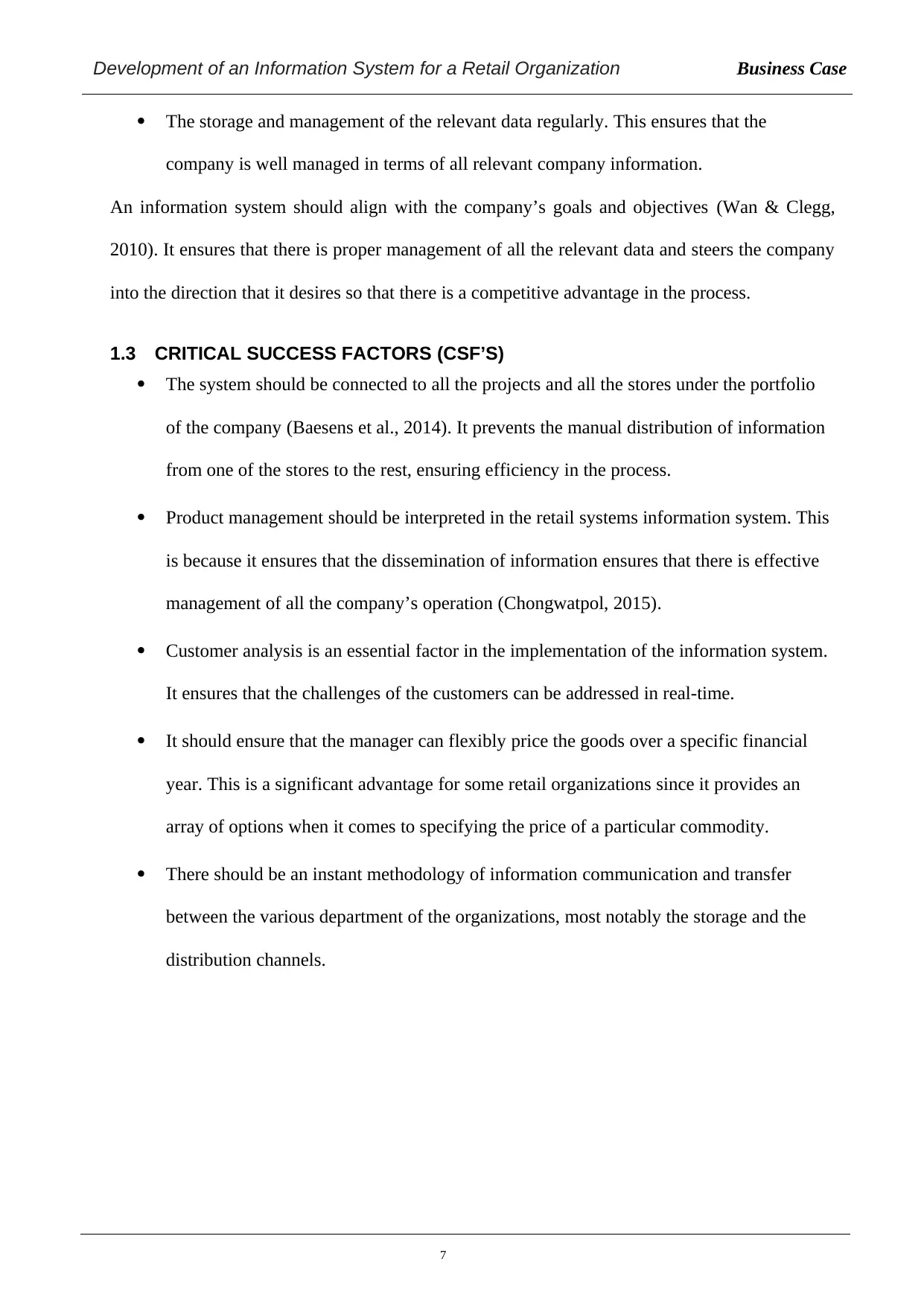
Development of an Information System for a Retail Organization Business Case
The storage and management of the relevant data regularly. This ensures that the
company is well managed in terms of all relevant company information.
An information system should align with the company’s goals and objectives (Wan & Clegg,
2010). It ensures that there is proper management of all the relevant data and steers the company
into the direction that it desires so that there is a competitive advantage in the process.
1.3 CRITICAL SUCCESS FACTORS (CSF’S)
The system should be connected to all the projects and all the stores under the portfolio
of the company (Baesens et al., 2014). It prevents the manual distribution of information
from one of the stores to the rest, ensuring efficiency in the process.
Product management should be interpreted in the retail systems information system. This
is because it ensures that the dissemination of information ensures that there is effective
management of all the company’s operation (Chongwatpol, 2015).
Customer analysis is an essential factor in the implementation of the information system.
It ensures that the challenges of the customers can be addressed in real-time.
It should ensure that the manager can flexibly price the goods over a specific financial
year. This is a significant advantage for some retail organizations since it provides an
array of options when it comes to specifying the price of a particular commodity.
There should be an instant methodology of information communication and transfer
between the various department of the organizations, most notably the storage and the
distribution channels.
7
The storage and management of the relevant data regularly. This ensures that the
company is well managed in terms of all relevant company information.
An information system should align with the company’s goals and objectives (Wan & Clegg,
2010). It ensures that there is proper management of all the relevant data and steers the company
into the direction that it desires so that there is a competitive advantage in the process.
1.3 CRITICAL SUCCESS FACTORS (CSF’S)
The system should be connected to all the projects and all the stores under the portfolio
of the company (Baesens et al., 2014). It prevents the manual distribution of information
from one of the stores to the rest, ensuring efficiency in the process.
Product management should be interpreted in the retail systems information system. This
is because it ensures that the dissemination of information ensures that there is effective
management of all the company’s operation (Chongwatpol, 2015).
Customer analysis is an essential factor in the implementation of the information system.
It ensures that the challenges of the customers can be addressed in real-time.
It should ensure that the manager can flexibly price the goods over a specific financial
year. This is a significant advantage for some retail organizations since it provides an
array of options when it comes to specifying the price of a particular commodity.
There should be an instant methodology of information communication and transfer
between the various department of the organizations, most notably the storage and the
distribution channels.
7
Paraphrase This Document
Need a fresh take? Get an instant paraphrase of this document with our AI Paraphraser

Development of an Information System for a Retail Organization Business Case
1.4 ORGANISATIONAL CHANGE
Changes in the organization structure may pose a significant challenge to the implementation of
an information system (Rastogi & Trivedi, 2016).. In this regard, implementation of the system
needs to concisely project the changes int the external environment and the internal environment.
In this regard, the information system needs to change as per the changes in the retail industry
(Ponsen & Ruijter, 2002).
8
1.4 ORGANISATIONAL CHANGE
Changes in the organization structure may pose a significant challenge to the implementation of
an information system (Rastogi & Trivedi, 2016).. In this regard, implementation of the system
needs to concisely project the changes int the external environment and the internal environment.
In this regard, the information system needs to change as per the changes in the retail industry
(Ponsen & Ruijter, 2002).
8

Development of an Information System for a Retail Organization Business Case
2 OPTIONS ANALYSIS
2.1 OPTIONS CONSIDERED
Nevertheless, the options depend on the sales forecasting capabilities of the system
(Aversano, Grasso, & Tortorell, 2011). In this regard, the system ensures that there is a
proper framework in the management and moreover, ensures that budgetary allocations are
managed in the most efficient and conservative manner.
There is also the importance of efficient inventory management (Moses, 2018). In this
regard, it is essential to ensure that there is stock management. This involves the
management of store processes such as first in first out and last in early out. The overall
system, as such, is meant to ensure that the store managers are not burdened with the whole
process of managing what goes into the storeroom and what is contained in the storeroom.
The security offered by the system is also imperative in determining the possibility of
implementation in a retail organization. The system ensures that all the company information
are secured from theft and destruction. Therefore, there is a need to consider all the
accessories of the system, such as cameras, management checks, and sensory management.
2.2 OPTIONS EVALUATION CRITERIA
One of the criteria used in the evaluation process depends on the familiarity of the
management with the systems. There are several options available at the disposal of the
management, but the selection should ensure that there is familiarity with a selected,
system (Maull, Geraldi, & Johnston, 2012). This is because competence in the
management of the system is essential in ensuring that the company can reap maximum
benefits from the system implementation.
Secondly, there is a need to understand other factors, besides the technicality of the
system (Loosemore, Danity, & Lingard, 2011). Research shows that concentration on the
technical characteristics tends to be myopic. Therefore, there is a need to ensure that
9
2 OPTIONS ANALYSIS
2.1 OPTIONS CONSIDERED
Nevertheless, the options depend on the sales forecasting capabilities of the system
(Aversano, Grasso, & Tortorell, 2011). In this regard, the system ensures that there is a
proper framework in the management and moreover, ensures that budgetary allocations are
managed in the most efficient and conservative manner.
There is also the importance of efficient inventory management (Moses, 2018). In this
regard, it is essential to ensure that there is stock management. This involves the
management of store processes such as first in first out and last in early out. The overall
system, as such, is meant to ensure that the store managers are not burdened with the whole
process of managing what goes into the storeroom and what is contained in the storeroom.
The security offered by the system is also imperative in determining the possibility of
implementation in a retail organization. The system ensures that all the company information
are secured from theft and destruction. Therefore, there is a need to consider all the
accessories of the system, such as cameras, management checks, and sensory management.
2.2 OPTIONS EVALUATION CRITERIA
One of the criteria used in the evaluation process depends on the familiarity of the
management with the systems. There are several options available at the disposal of the
management, but the selection should ensure that there is familiarity with a selected,
system (Maull, Geraldi, & Johnston, 2012). This is because competence in the
management of the system is essential in ensuring that the company can reap maximum
benefits from the system implementation.
Secondly, there is a need to understand other factors, besides the technicality of the
system (Loosemore, Danity, & Lingard, 2011). Research shows that concentration on the
technical characteristics tends to be myopic. Therefore, there is a need to ensure that
9
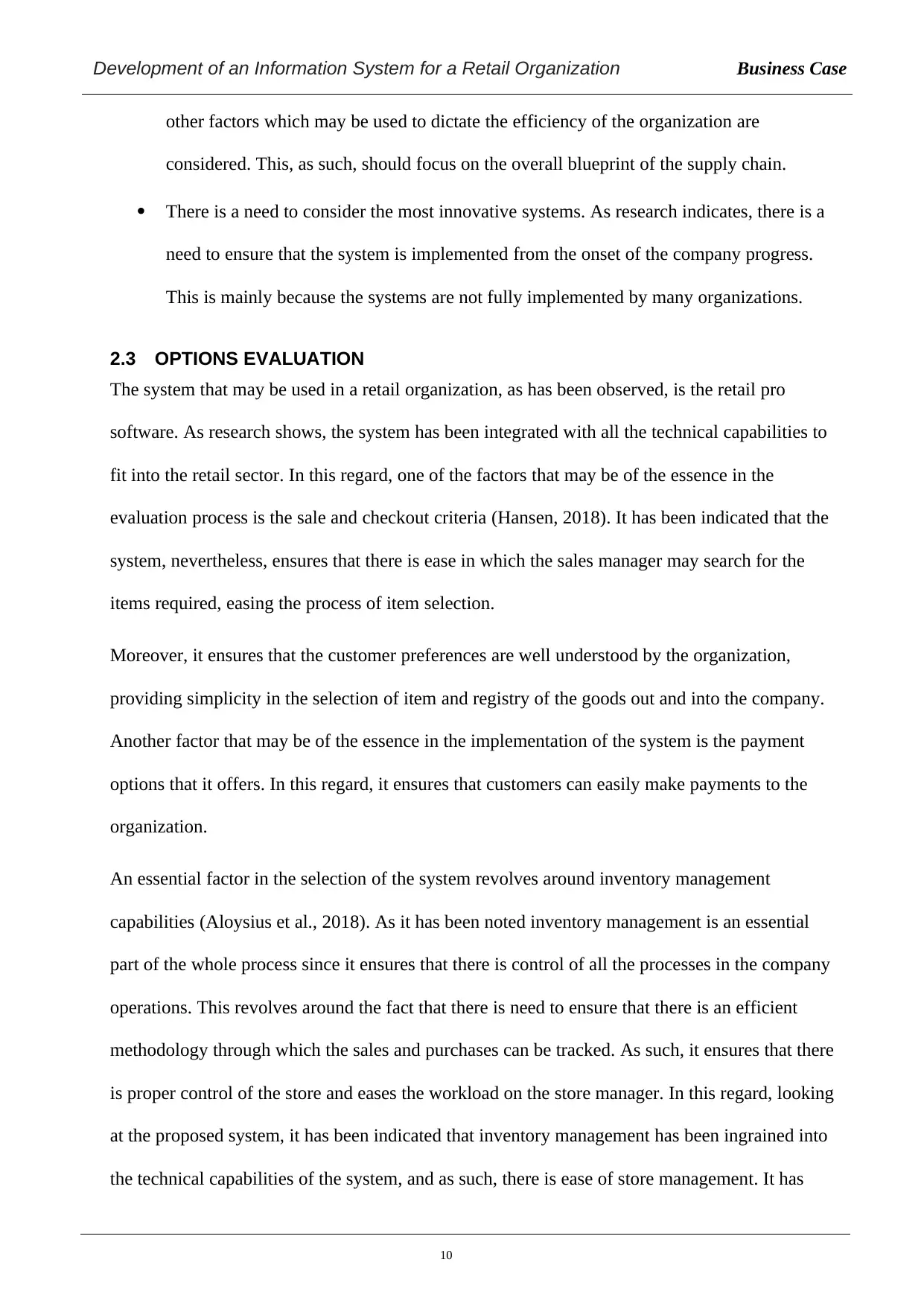
Development of an Information System for a Retail Organization Business Case
other factors which may be used to dictate the efficiency of the organization are
considered. This, as such, should focus on the overall blueprint of the supply chain.
There is a need to consider the most innovative systems. As research indicates, there is a
need to ensure that the system is implemented from the onset of the company progress.
This is mainly because the systems are not fully implemented by many organizations.
2.3 OPTIONS EVALUATION
The system that may be used in a retail organization, as has been observed, is the retail pro
software. As research shows, the system has been integrated with all the technical capabilities to
fit into the retail sector. In this regard, one of the factors that may be of the essence in the
evaluation process is the sale and checkout criteria (Hansen, 2018). It has been indicated that the
system, nevertheless, ensures that there is ease in which the sales manager may search for the
items required, easing the process of item selection.
Moreover, it ensures that the customer preferences are well understood by the organization,
providing simplicity in the selection of item and registry of the goods out and into the company.
Another factor that may be of the essence in the implementation of the system is the payment
options that it offers. In this regard, it ensures that customers can easily make payments to the
organization.
An essential factor in the selection of the system revolves around inventory management
capabilities (Aloysius et al., 2018). As it has been noted inventory management is an essential
part of the whole process since it ensures that there is control of all the processes in the company
operations. This revolves around the fact that there is need to ensure that there is an efficient
methodology through which the sales and purchases can be tracked. As such, it ensures that there
is proper control of the store and eases the workload on the store manager. In this regard, looking
at the proposed system, it has been indicated that inventory management has been ingrained into
the technical capabilities of the system, and as such, there is ease of store management. It has
10
other factors which may be used to dictate the efficiency of the organization are
considered. This, as such, should focus on the overall blueprint of the supply chain.
There is a need to consider the most innovative systems. As research indicates, there is a
need to ensure that the system is implemented from the onset of the company progress.
This is mainly because the systems are not fully implemented by many organizations.
2.3 OPTIONS EVALUATION
The system that may be used in a retail organization, as has been observed, is the retail pro
software. As research shows, the system has been integrated with all the technical capabilities to
fit into the retail sector. In this regard, one of the factors that may be of the essence in the
evaluation process is the sale and checkout criteria (Hansen, 2018). It has been indicated that the
system, nevertheless, ensures that there is ease in which the sales manager may search for the
items required, easing the process of item selection.
Moreover, it ensures that the customer preferences are well understood by the organization,
providing simplicity in the selection of item and registry of the goods out and into the company.
Another factor that may be of the essence in the implementation of the system is the payment
options that it offers. In this regard, it ensures that customers can easily make payments to the
organization.
An essential factor in the selection of the system revolves around inventory management
capabilities (Aloysius et al., 2018). As it has been noted inventory management is an essential
part of the whole process since it ensures that there is control of all the processes in the company
operations. This revolves around the fact that there is need to ensure that there is an efficient
methodology through which the sales and purchases can be tracked. As such, it ensures that there
is proper control of the store and eases the workload on the store manager. In this regard, looking
at the proposed system, it has been indicated that inventory management has been ingrained into
the technical capabilities of the system, and as such, there is ease of store management. It has
10
Secure Best Marks with AI Grader
Need help grading? Try our AI Grader for instant feedback on your assignments.

Development of an Information System for a Retail Organization Business Case
been noted that the system has the ability to monitoring and managing the whole supply chain of
the system. There is ease of control from the manufacturing stage to the sales stage. Moreover,
the system has been designed to track an unlimited number of inventories.
Moreover, the inventory capabilities of the system ensure that the company can easily track the
movement of goods from one region to another or from one store to another. This may be
through the management of the serial numbers of the company products. This, as such, ensures
that there is efficiency regarding the purchase of goods and services.
Option Description
1 Retail pro Software
2 ERP software
Table 2-1
2.4 RECOMMENDED OPTION
There is a need to ensure that the system can manage the inventories in an efficient and orderly
manner. The stocks of the company are essential since they dictate the whole supply chain. The
proposed method, as such, has used this as one of its core factors. Inventory control, as such, is
meant to ensure that the losses, sales, and even the defects can be managed in the whole supply
chain. It, as such, ensures that there is a reduction in the workload of the store manager. In more
pronounced terms, it ensures that the manual errors that are associated with a store manager are
eliminated.
Another important recommendation is the fact that there is a need to ensure that all the workers
are competent regarding the operations of the system. As was indicated initially, the competence
of the system is essential in ensuring that the system works at an optimum. The retail pro nine
has been designed using the latest retail technology needs, and as such, its capabilities are more
pronounced if the management is well conversant with the operational requirements. To fully
11
been noted that the system has the ability to monitoring and managing the whole supply chain of
the system. There is ease of control from the manufacturing stage to the sales stage. Moreover,
the system has been designed to track an unlimited number of inventories.
Moreover, the inventory capabilities of the system ensure that the company can easily track the
movement of goods from one region to another or from one store to another. This may be
through the management of the serial numbers of the company products. This, as such, ensures
that there is efficiency regarding the purchase of goods and services.
Option Description
1 Retail pro Software
2 ERP software
Table 2-1
2.4 RECOMMENDED OPTION
There is a need to ensure that the system can manage the inventories in an efficient and orderly
manner. The stocks of the company are essential since they dictate the whole supply chain. The
proposed method, as such, has used this as one of its core factors. Inventory control, as such, is
meant to ensure that the losses, sales, and even the defects can be managed in the whole supply
chain. It, as such, ensures that there is a reduction in the workload of the store manager. In more
pronounced terms, it ensures that the manual errors that are associated with a store manager are
eliminated.
Another important recommendation is the fact that there is a need to ensure that all the workers
are competent regarding the operations of the system. As was indicated initially, the competence
of the system is essential in ensuring that the system works at an optimum. The retail pro nine
has been designed using the latest retail technology needs, and as such, its capabilities are more
pronounced if the management is well conversant with the operational requirements. To fully
11
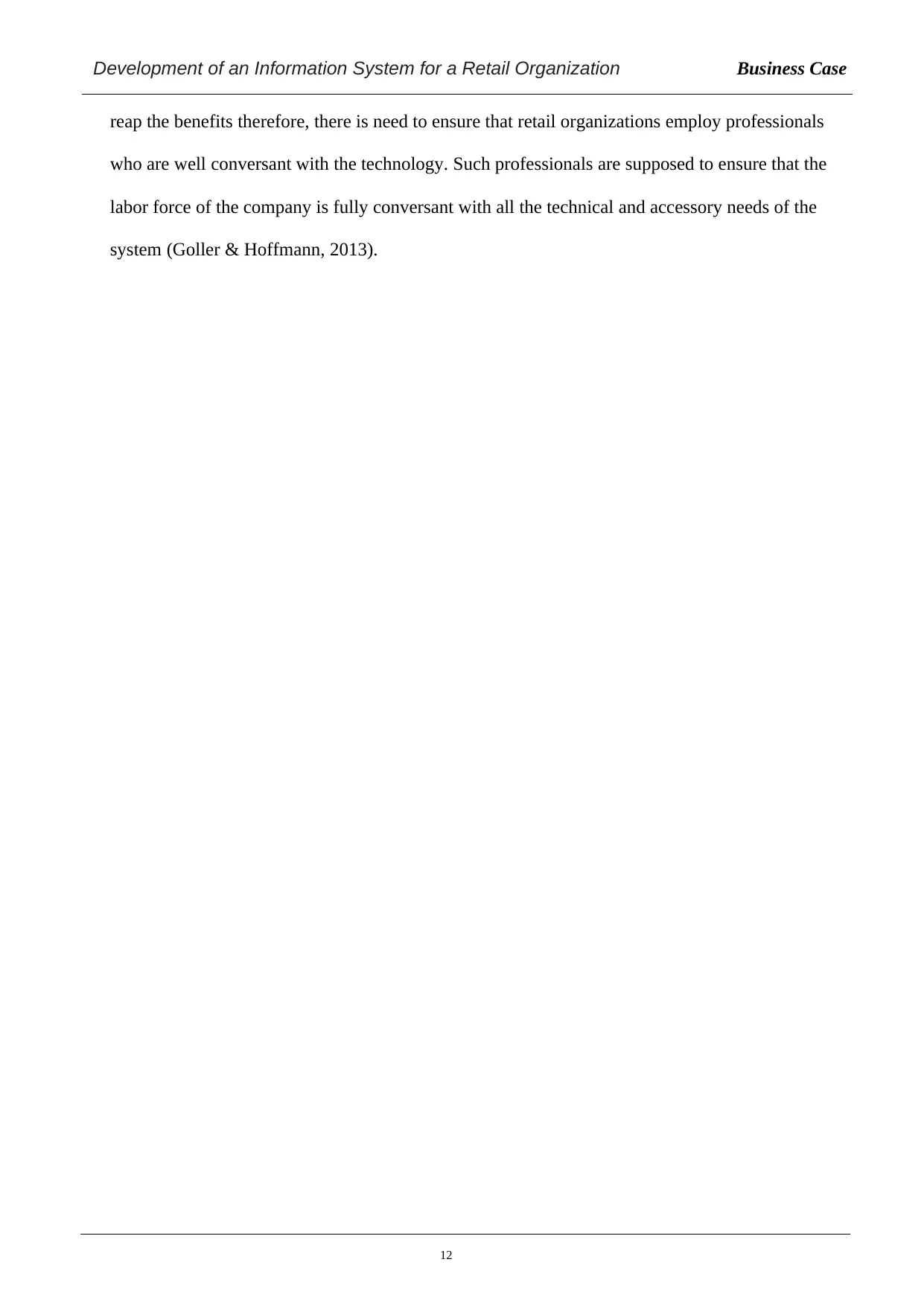
Development of an Information System for a Retail Organization Business Case
reap the benefits therefore, there is need to ensure that retail organizations employ professionals
who are well conversant with the technology. Such professionals are supposed to ensure that the
labor force of the company is fully conversant with all the technical and accessory needs of the
system (Goller & Hoffmann, 2013).
12
reap the benefits therefore, there is need to ensure that retail organizations employ professionals
who are well conversant with the technology. Such professionals are supposed to ensure that the
labor force of the company is fully conversant with all the technical and accessory needs of the
system (Goller & Hoffmann, 2013).
12
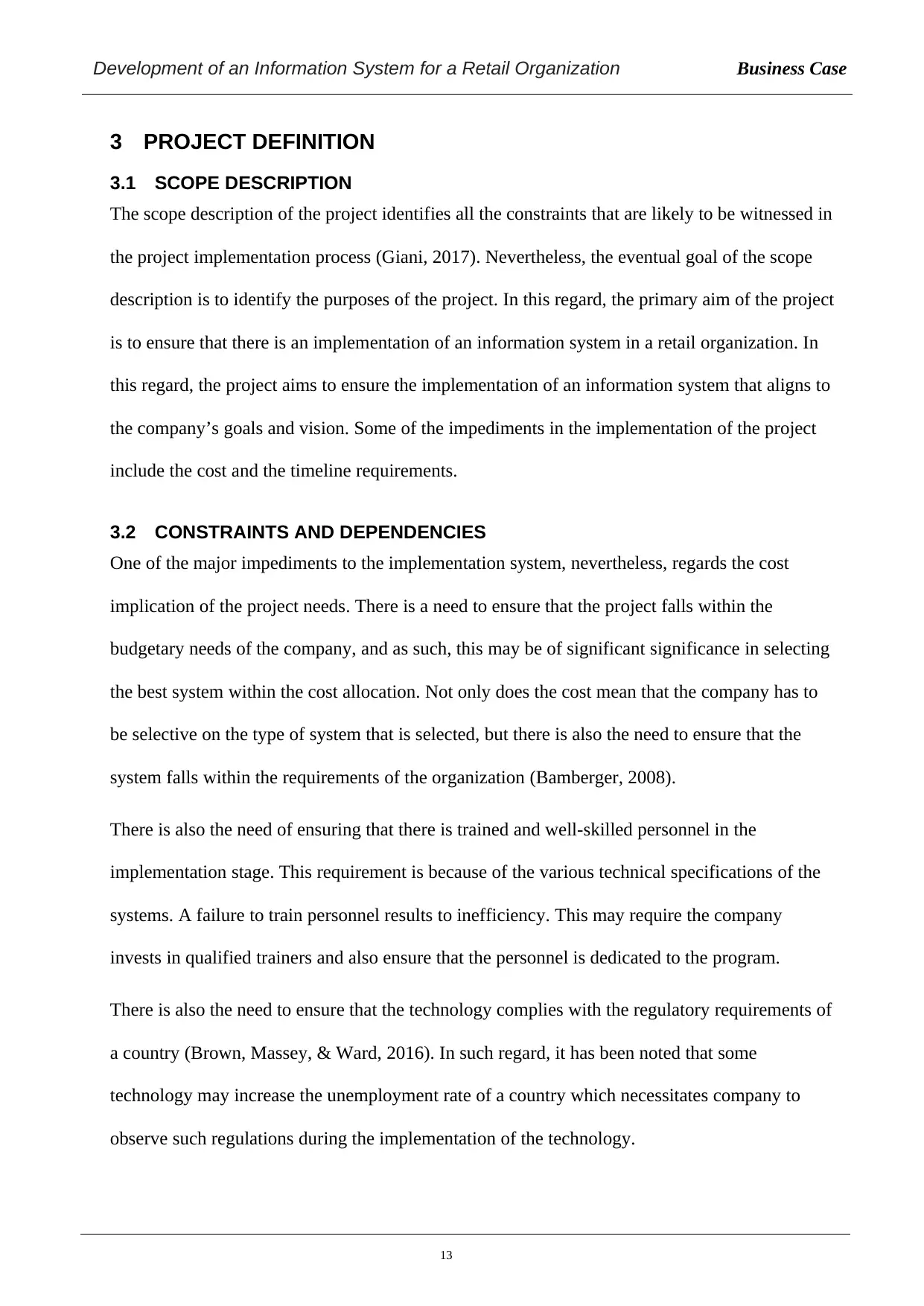
Development of an Information System for a Retail Organization Business Case
3 PROJECT DEFINITION
3.1 SCOPE DESCRIPTION
The scope description of the project identifies all the constraints that are likely to be witnessed in
the project implementation process (Giani, 2017). Nevertheless, the eventual goal of the scope
description is to identify the purposes of the project. In this regard, the primary aim of the project
is to ensure that there is an implementation of an information system in a retail organization. In
this regard, the project aims to ensure the implementation of an information system that aligns to
the company’s goals and vision. Some of the impediments in the implementation of the project
include the cost and the timeline requirements.
3.2 CONSTRAINTS AND DEPENDENCIES
One of the major impediments to the implementation system, nevertheless, regards the cost
implication of the project needs. There is a need to ensure that the project falls within the
budgetary needs of the company, and as such, this may be of significant significance in selecting
the best system within the cost allocation. Not only does the cost mean that the company has to
be selective on the type of system that is selected, but there is also the need to ensure that the
system falls within the requirements of the organization (Bamberger, 2008).
There is also the need of ensuring that there is trained and well-skilled personnel in the
implementation stage. This requirement is because of the various technical specifications of the
systems. A failure to train personnel results to inefficiency. This may require the company
invests in qualified trainers and also ensure that the personnel is dedicated to the program.
There is also the need to ensure that the technology complies with the regulatory requirements of
a country (Brown, Massey, & Ward, 2016). In such regard, it has been noted that some
technology may increase the unemployment rate of a country which necessitates company to
observe such regulations during the implementation of the technology.
13
3 PROJECT DEFINITION
3.1 SCOPE DESCRIPTION
The scope description of the project identifies all the constraints that are likely to be witnessed in
the project implementation process (Giani, 2017). Nevertheless, the eventual goal of the scope
description is to identify the purposes of the project. In this regard, the primary aim of the project
is to ensure that there is an implementation of an information system in a retail organization. In
this regard, the project aims to ensure the implementation of an information system that aligns to
the company’s goals and vision. Some of the impediments in the implementation of the project
include the cost and the timeline requirements.
3.2 CONSTRAINTS AND DEPENDENCIES
One of the major impediments to the implementation system, nevertheless, regards the cost
implication of the project needs. There is a need to ensure that the project falls within the
budgetary needs of the company, and as such, this may be of significant significance in selecting
the best system within the cost allocation. Not only does the cost mean that the company has to
be selective on the type of system that is selected, but there is also the need to ensure that the
system falls within the requirements of the organization (Bamberger, 2008).
There is also the need of ensuring that there is trained and well-skilled personnel in the
implementation stage. This requirement is because of the various technical specifications of the
systems. A failure to train personnel results to inefficiency. This may require the company
invests in qualified trainers and also ensure that the personnel is dedicated to the program.
There is also the need to ensure that the technology complies with the regulatory requirements of
a country (Brown, Massey, & Ward, 2016). In such regard, it has been noted that some
technology may increase the unemployment rate of a country which necessitates company to
observe such regulations during the implementation of the technology.
13
Paraphrase This Document
Need a fresh take? Get an instant paraphrase of this document with our AI Paraphraser
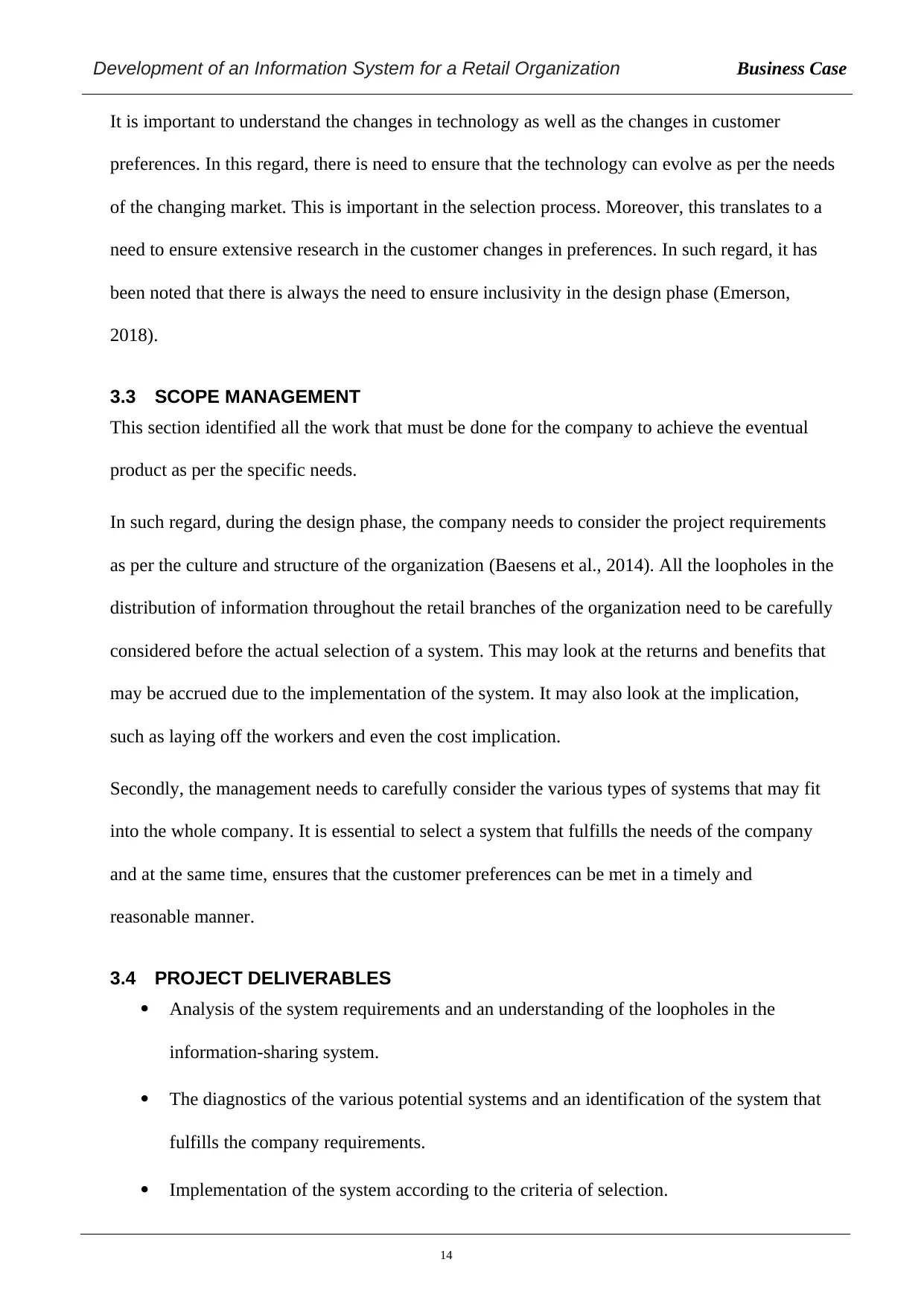
Development of an Information System for a Retail Organization Business Case
It is important to understand the changes in technology as well as the changes in customer
preferences. In this regard, there is need to ensure that the technology can evolve as per the needs
of the changing market. This is important in the selection process. Moreover, this translates to a
need to ensure extensive research in the customer changes in preferences. In such regard, it has
been noted that there is always the need to ensure inclusivity in the design phase (Emerson,
2018).
3.3 SCOPE MANAGEMENT
This section identified all the work that must be done for the company to achieve the eventual
product as per the specific needs.
In such regard, during the design phase, the company needs to consider the project requirements
as per the culture and structure of the organization (Baesens et al., 2014). All the loopholes in the
distribution of information throughout the retail branches of the organization need to be carefully
considered before the actual selection of a system. This may look at the returns and benefits that
may be accrued due to the implementation of the system. It may also look at the implication,
such as laying off the workers and even the cost implication.
Secondly, the management needs to carefully consider the various types of systems that may fit
into the whole company. It is essential to select a system that fulfills the needs of the company
and at the same time, ensures that the customer preferences can be met in a timely and
reasonable manner.
3.4 PROJECT DELIVERABLES
Analysis of the system requirements and an understanding of the loopholes in the
information-sharing system.
The diagnostics of the various potential systems and an identification of the system that
fulfills the company requirements.
Implementation of the system according to the criteria of selection.
14
It is important to understand the changes in technology as well as the changes in customer
preferences. In this regard, there is need to ensure that the technology can evolve as per the needs
of the changing market. This is important in the selection process. Moreover, this translates to a
need to ensure extensive research in the customer changes in preferences. In such regard, it has
been noted that there is always the need to ensure inclusivity in the design phase (Emerson,
2018).
3.3 SCOPE MANAGEMENT
This section identified all the work that must be done for the company to achieve the eventual
product as per the specific needs.
In such regard, during the design phase, the company needs to consider the project requirements
as per the culture and structure of the organization (Baesens et al., 2014). All the loopholes in the
distribution of information throughout the retail branches of the organization need to be carefully
considered before the actual selection of a system. This may look at the returns and benefits that
may be accrued due to the implementation of the system. It may also look at the implication,
such as laying off the workers and even the cost implication.
Secondly, the management needs to carefully consider the various types of systems that may fit
into the whole company. It is essential to select a system that fulfills the needs of the company
and at the same time, ensures that the customer preferences can be met in a timely and
reasonable manner.
3.4 PROJECT DELIVERABLES
Analysis of the system requirements and an understanding of the loopholes in the
information-sharing system.
The diagnostics of the various potential systems and an identification of the system that
fulfills the company requirements.
Implementation of the system according to the criteria of selection.
14
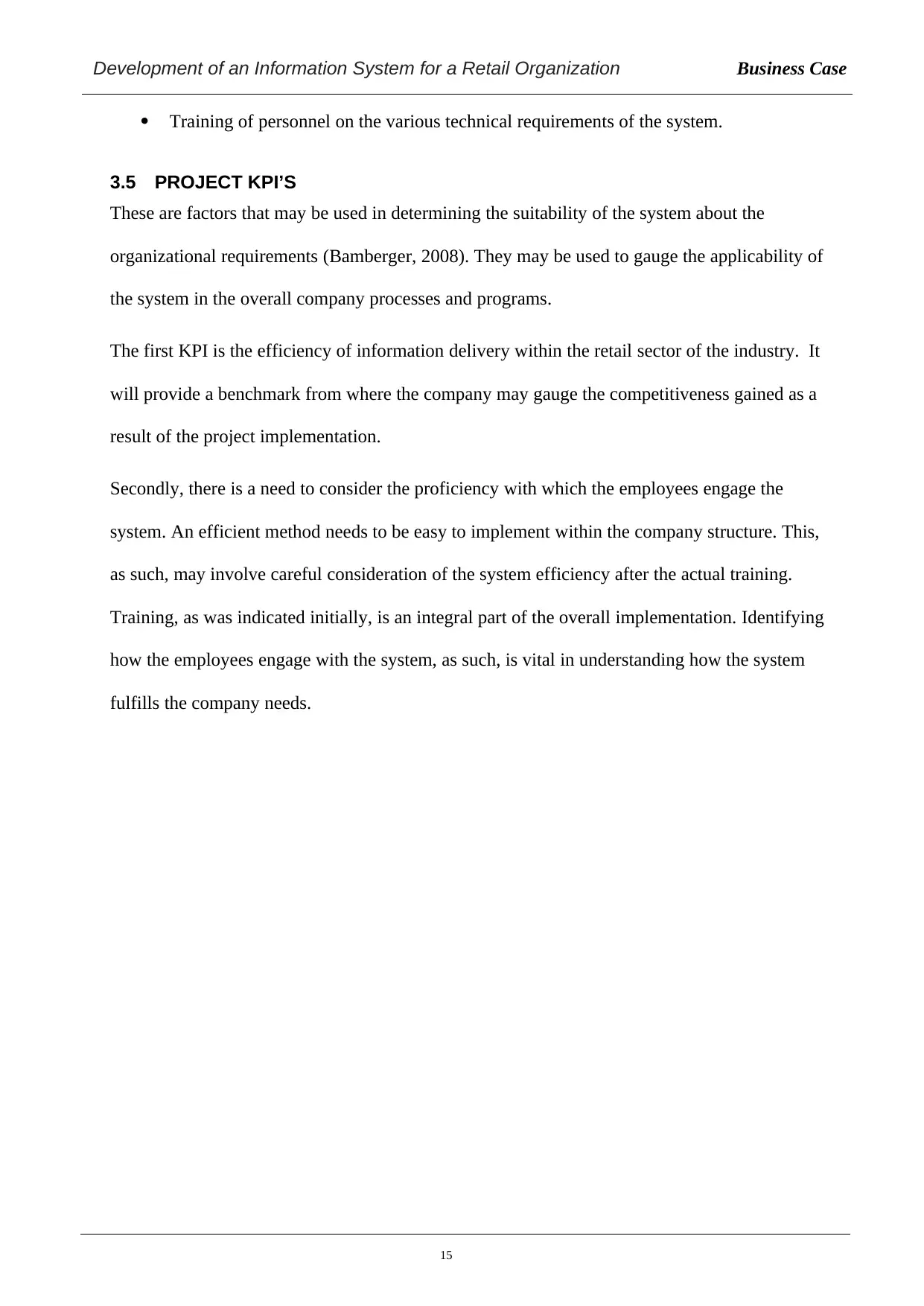
Development of an Information System for a Retail Organization Business Case
Training of personnel on the various technical requirements of the system.
3.5 PROJECT KPI’S
These are factors that may be used in determining the suitability of the system about the
organizational requirements (Bamberger, 2008). They may be used to gauge the applicability of
the system in the overall company processes and programs.
The first KPI is the efficiency of information delivery within the retail sector of the industry. It
will provide a benchmark from where the company may gauge the competitiveness gained as a
result of the project implementation.
Secondly, there is a need to consider the proficiency with which the employees engage the
system. An efficient method needs to be easy to implement within the company structure. This,
as such, may involve careful consideration of the system efficiency after the actual training.
Training, as was indicated initially, is an integral part of the overall implementation. Identifying
how the employees engage with the system, as such, is vital in understanding how the system
fulfills the company needs.
15
Training of personnel on the various technical requirements of the system.
3.5 PROJECT KPI’S
These are factors that may be used in determining the suitability of the system about the
organizational requirements (Bamberger, 2008). They may be used to gauge the applicability of
the system in the overall company processes and programs.
The first KPI is the efficiency of information delivery within the retail sector of the industry. It
will provide a benchmark from where the company may gauge the competitiveness gained as a
result of the project implementation.
Secondly, there is a need to consider the proficiency with which the employees engage the
system. An efficient method needs to be easy to implement within the company structure. This,
as such, may involve careful consideration of the system efficiency after the actual training.
Training, as was indicated initially, is an integral part of the overall implementation. Identifying
how the employees engage with the system, as such, is vital in understanding how the system
fulfills the company needs.
15
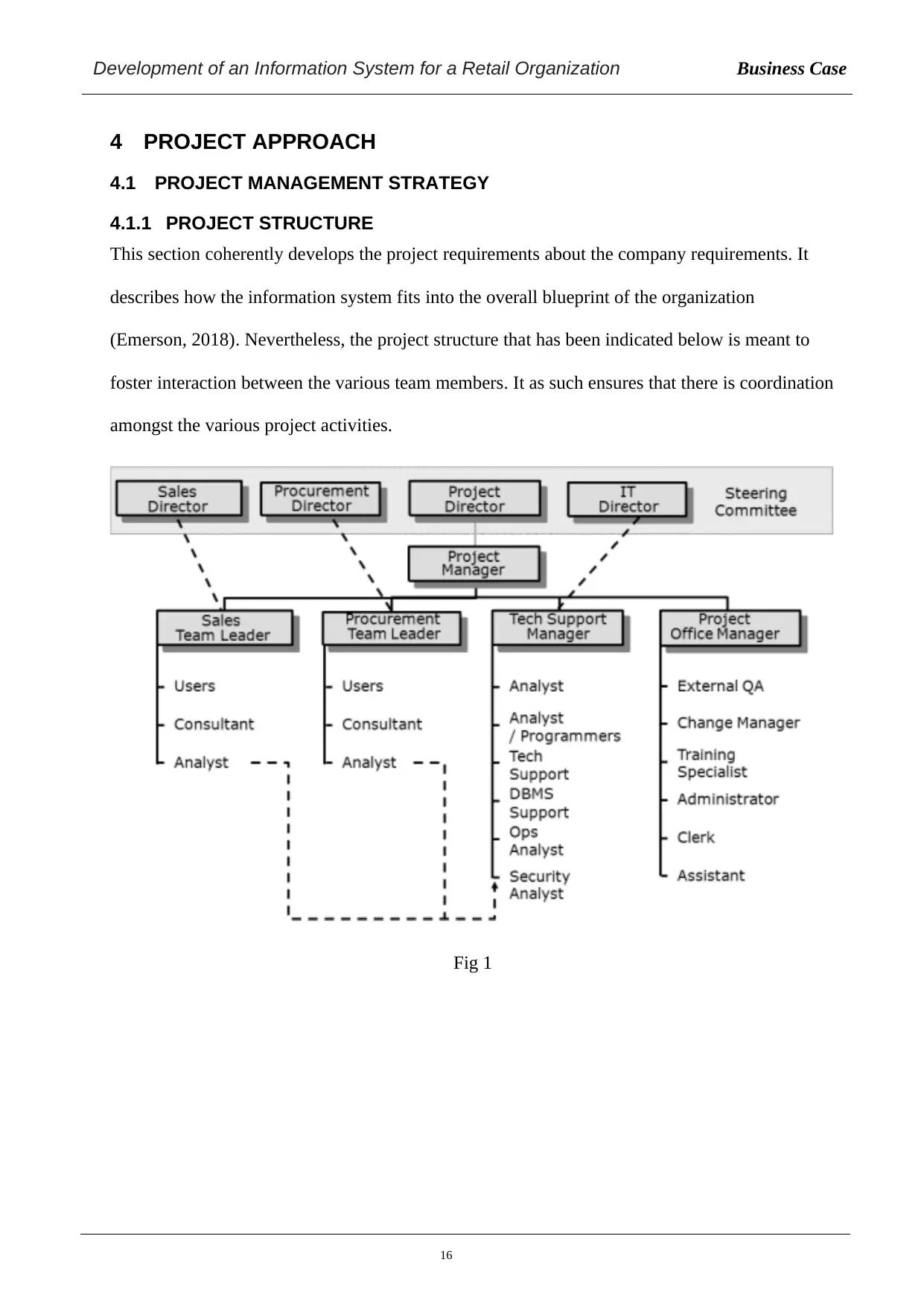
Development of an Information System for a Retail Organization Business Case
4 PROJECT APPROACH
4.1 PROJECT MANAGEMENT STRATEGY
4.1.1 PROJECT STRUCTURE
This section coherently develops the project requirements about the company requirements. It
describes how the information system fits into the overall blueprint of the organization
(Emerson, 2018). Nevertheless, the project structure that has been indicated below is meant to
foster interaction between the various team members. It as such ensures that there is coordination
amongst the various project activities.
Fig 1
16
4 PROJECT APPROACH
4.1 PROJECT MANAGEMENT STRATEGY
4.1.1 PROJECT STRUCTURE
This section coherently develops the project requirements about the company requirements. It
describes how the information system fits into the overall blueprint of the organization
(Emerson, 2018). Nevertheless, the project structure that has been indicated below is meant to
foster interaction between the various team members. It as such ensures that there is coordination
amongst the various project activities.
Fig 1
16
Secure Best Marks with AI Grader
Need help grading? Try our AI Grader for instant feedback on your assignments.

Development of an Information System for a Retail Organization Business Case
4.1.2 PROJECT GOVERNANCE FRAMEWORK
The governance framework has been regarded as the decision-making approach within the
organization. It is aimed at ensuring that all the decisions that are made regarding a specific
project are in line with the organization’s vision (Christopher & Ryals, 2014) and moreover, the
project is going to leas to returns in the short run and the long term.
Fig 2
4.1.3 PROJECT REPORTING STRUCTURE
This refers to the arrangement of authority in the organization. It is a chain of command which
must be followed for the effective implementation of the project. As such, it provides a
benchmark from where the decision-making process is made. Therefore, it communicates to the
personnel involved in the project.
17
4.1.2 PROJECT GOVERNANCE FRAMEWORK
The governance framework has been regarded as the decision-making approach within the
organization. It is aimed at ensuring that all the decisions that are made regarding a specific
project are in line with the organization’s vision (Christopher & Ryals, 2014) and moreover, the
project is going to leas to returns in the short run and the long term.
Fig 2
4.1.3 PROJECT REPORTING STRUCTURE
This refers to the arrangement of authority in the organization. It is a chain of command which
must be followed for the effective implementation of the project. As such, it provides a
benchmark from where the decision-making process is made. Therefore, it communicates to the
personnel involved in the project.
17
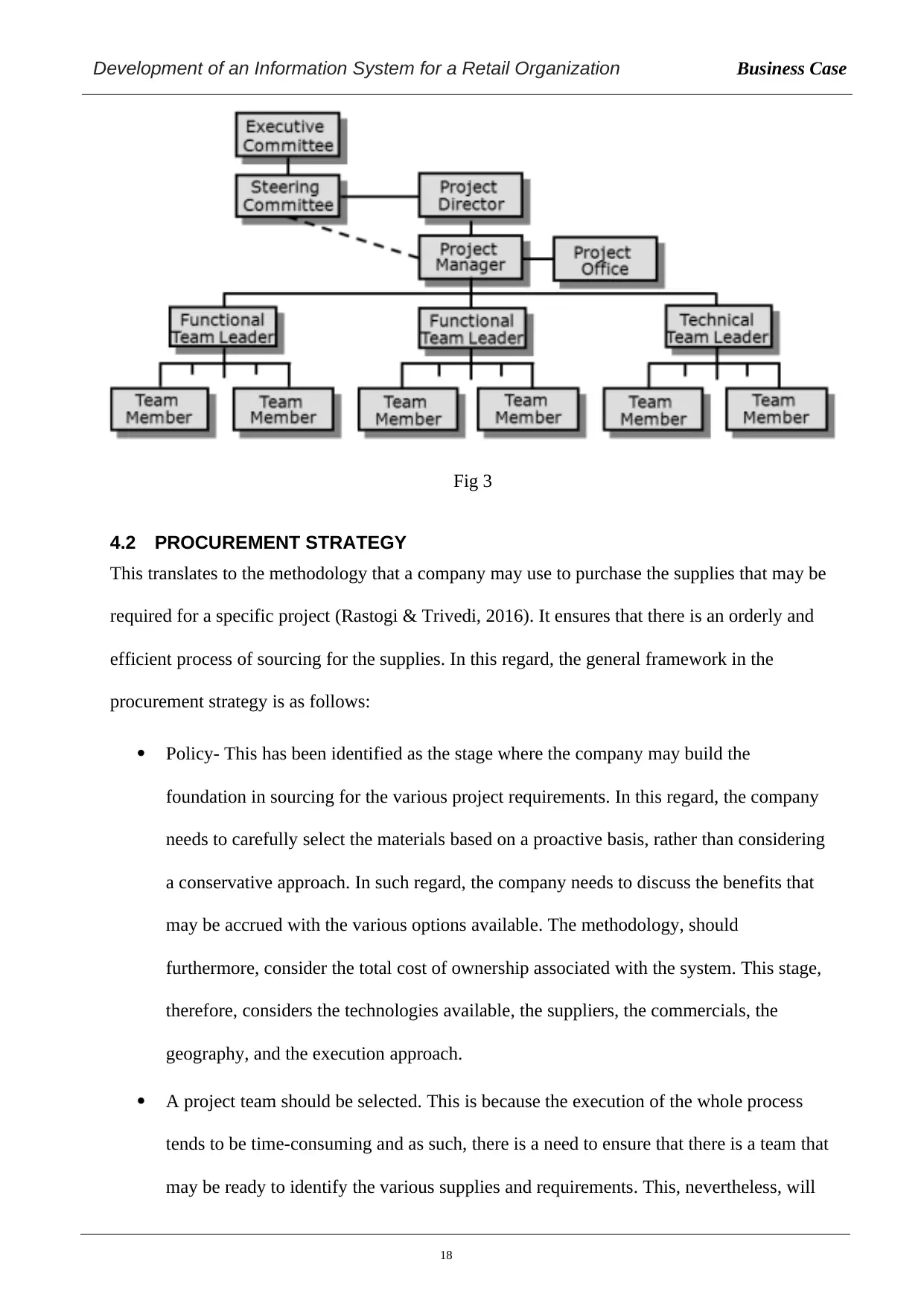
Development of an Information System for a Retail Organization Business Case
Fig 3
4.2 PROCUREMENT STRATEGY
This translates to the methodology that a company may use to purchase the supplies that may be
required for a specific project (Rastogi & Trivedi, 2016). It ensures that there is an orderly and
efficient process of sourcing for the supplies. In this regard, the general framework in the
procurement strategy is as follows:
Policy- This has been identified as the stage where the company may build the
foundation in sourcing for the various project requirements. In this regard, the company
needs to carefully select the materials based on a proactive basis, rather than considering
a conservative approach. In such regard, the company needs to discuss the benefits that
may be accrued with the various options available. The methodology, should
furthermore, consider the total cost of ownership associated with the system. This stage,
therefore, considers the technologies available, the suppliers, the commercials, the
geography, and the execution approach.
A project team should be selected. This is because the execution of the whole process
tends to be time-consuming and as such, there is a need to ensure that there is a team that
may be ready to identify the various supplies and requirements. This, nevertheless, will
18
Fig 3
4.2 PROCUREMENT STRATEGY
This translates to the methodology that a company may use to purchase the supplies that may be
required for a specific project (Rastogi & Trivedi, 2016). It ensures that there is an orderly and
efficient process of sourcing for the supplies. In this regard, the general framework in the
procurement strategy is as follows:
Policy- This has been identified as the stage where the company may build the
foundation in sourcing for the various project requirements. In this regard, the company
needs to carefully select the materials based on a proactive basis, rather than considering
a conservative approach. In such regard, the company needs to discuss the benefits that
may be accrued with the various options available. The methodology, should
furthermore, consider the total cost of ownership associated with the system. This stage,
therefore, considers the technologies available, the suppliers, the commercials, the
geography, and the execution approach.
A project team should be selected. This is because the execution of the whole process
tends to be time-consuming and as such, there is a need to ensure that there is a team that
may be ready to identify the various supplies and requirements. This, nevertheless, will
18

Development of an Information System for a Retail Organization Business Case
be dependent on the level of service that needs to be sourced. The number of team
members is dependent on the project needs.
Pre-contract diligence- This has been identified as one of the essential souring phases.
Therefore, it is wise to understand that an increase in the information available may lead
to a more comprehensive and efficient procurement methodology. The pre-counter
diligence data, in this regard, is imperative when sourcing for supplies.
It is essential to shortlist the suppliers as per the RFP process. The supplier, in this case,
needs to be as proactive as possible in ensuring that the end-user needs are indicated
(Bamberger, 2008).
4.3 COMMUNICATION AND STAKEHOLDER MANAGEMENT STRATEGY
The strategy is implemented to ensure that there is no negativity between the various
stakeholders. It is aimed at ensuring that there is an increase in support throughout the project
implementation phase.
19
be dependent on the level of service that needs to be sourced. The number of team
members is dependent on the project needs.
Pre-contract diligence- This has been identified as one of the essential souring phases.
Therefore, it is wise to understand that an increase in the information available may lead
to a more comprehensive and efficient procurement methodology. The pre-counter
diligence data, in this regard, is imperative when sourcing for supplies.
It is essential to shortlist the suppliers as per the RFP process. The supplier, in this case,
needs to be as proactive as possible in ensuring that the end-user needs are indicated
(Bamberger, 2008).
4.3 COMMUNICATION AND STAKEHOLDER MANAGEMENT STRATEGY
The strategy is implemented to ensure that there is no negativity between the various
stakeholders. It is aimed at ensuring that there is an increase in support throughout the project
implementation phase.
19
Paraphrase This Document
Need a fresh take? Get an instant paraphrase of this document with our AI Paraphraser
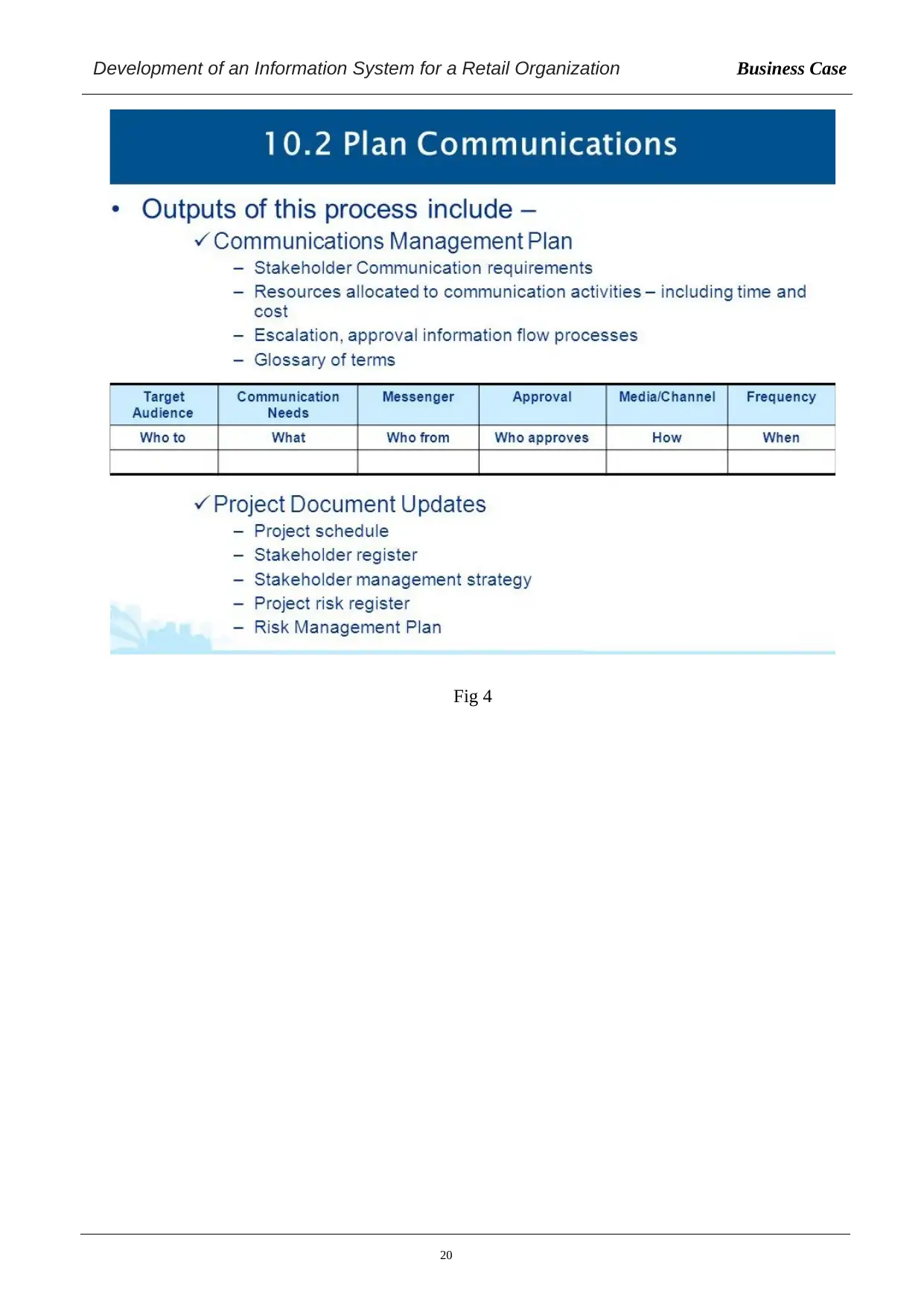
Development of an Information System for a Retail Organization Business Case
Fig 4
20
Fig 4
20
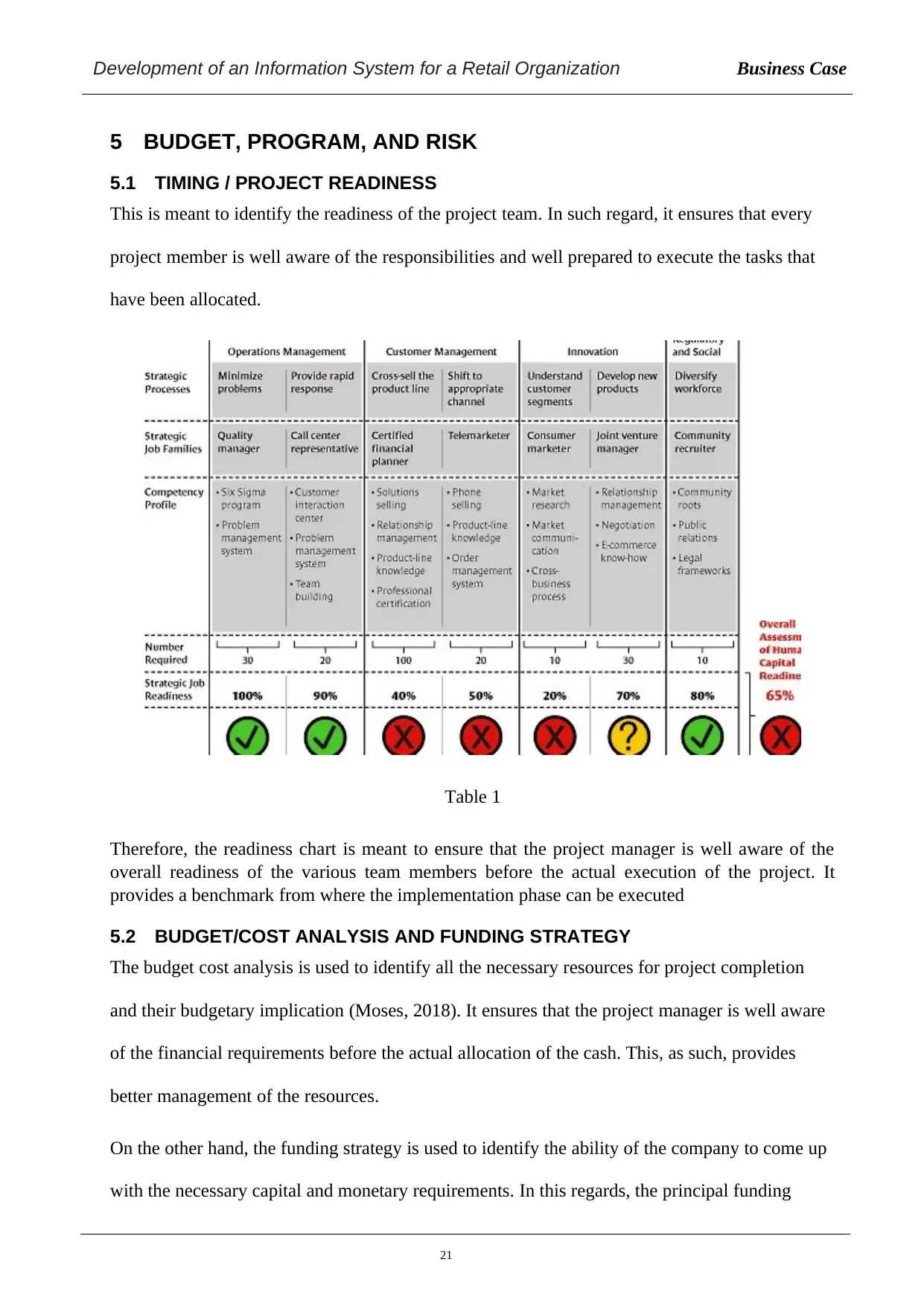
Development of an Information System for a Retail Organization Business Case
5 BUDGET, PROGRAM, AND RISK
5.1 TIMING / PROJECT READINESS
This is meant to identify the readiness of the project team. In such regard, it ensures that every
project member is well aware of the responsibilities and well prepared to execute the tasks that
have been allocated.
Table 1
Therefore, the readiness chart is meant to ensure that the project manager is well aware of the
overall readiness of the various team members before the actual execution of the project. It
provides a benchmark from where the implementation phase can be executed
5.2 BUDGET/COST ANALYSIS AND FUNDING STRATEGY
The budget cost analysis is used to identify all the necessary resources for project completion
and their budgetary implication (Moses, 2018). It ensures that the project manager is well aware
of the financial requirements before the actual allocation of the cash. This, as such, provides
better management of the resources.
On the other hand, the funding strategy is used to identify the ability of the company to come up
with the necessary capital and monetary requirements. In this regards, the principal funding
21
5 BUDGET, PROGRAM, AND RISK
5.1 TIMING / PROJECT READINESS
This is meant to identify the readiness of the project team. In such regard, it ensures that every
project member is well aware of the responsibilities and well prepared to execute the tasks that
have been allocated.
Table 1
Therefore, the readiness chart is meant to ensure that the project manager is well aware of the
overall readiness of the various team members before the actual execution of the project. It
provides a benchmark from where the implementation phase can be executed
5.2 BUDGET/COST ANALYSIS AND FUNDING STRATEGY
The budget cost analysis is used to identify all the necessary resources for project completion
and their budgetary implication (Moses, 2018). It ensures that the project manager is well aware
of the financial requirements before the actual allocation of the cash. This, as such, provides
better management of the resources.
On the other hand, the funding strategy is used to identify the ability of the company to come up
with the necessary capital and monetary requirements. In this regards, the principal funding
21
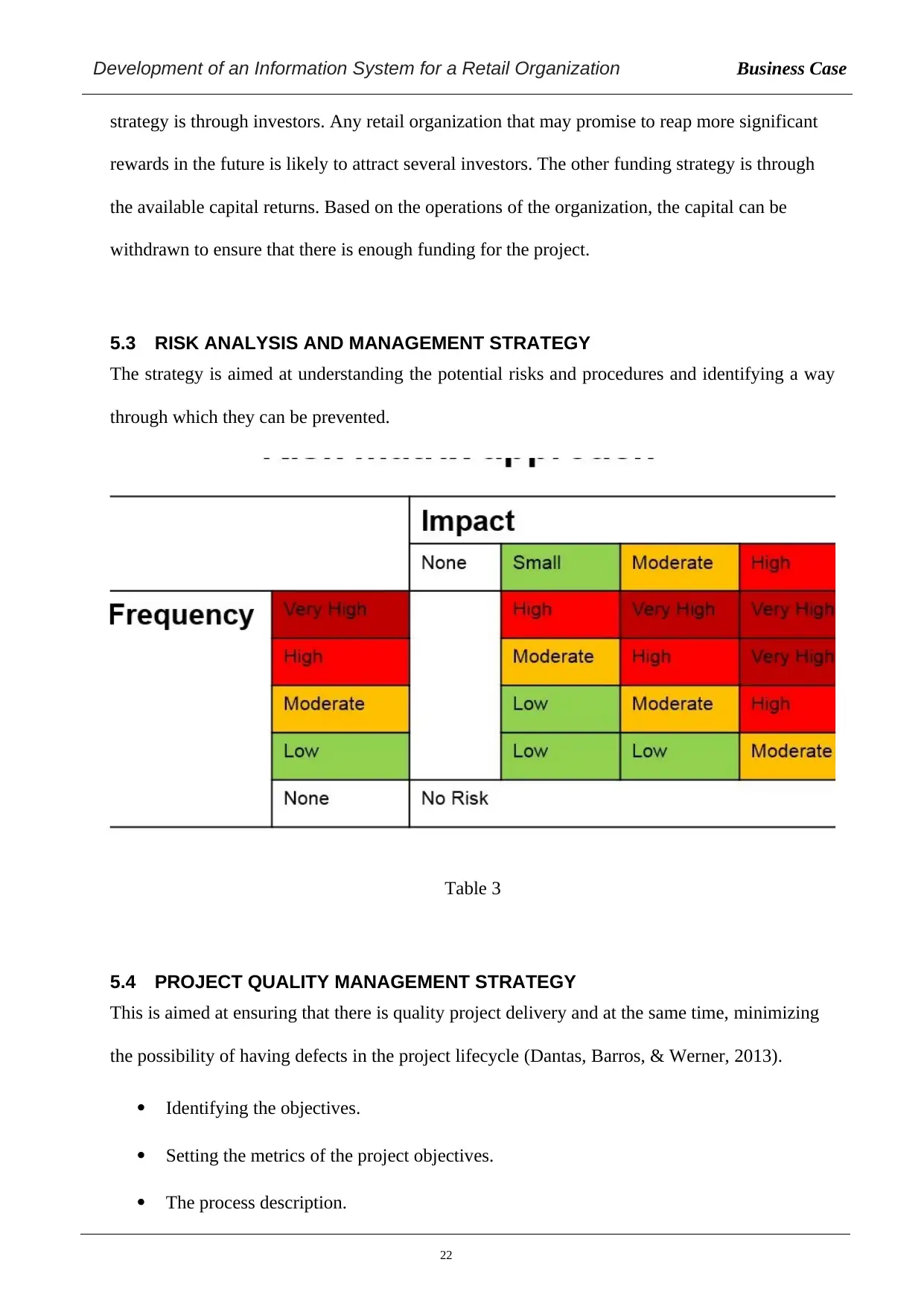
Development of an Information System for a Retail Organization Business Case
strategy is through investors. Any retail organization that may promise to reap more significant
rewards in the future is likely to attract several investors. The other funding strategy is through
the available capital returns. Based on the operations of the organization, the capital can be
withdrawn to ensure that there is enough funding for the project.
5.3 RISK ANALYSIS AND MANAGEMENT STRATEGY
The strategy is aimed at understanding the potential risks and procedures and identifying a way
through which they can be prevented.
Table 3
5.4 PROJECT QUALITY MANAGEMENT STRATEGY
This is aimed at ensuring that there is quality project delivery and at the same time, minimizing
the possibility of having defects in the project lifecycle (Dantas, Barros, & Werner, 2013).
Identifying the objectives.
Setting the metrics of the project objectives.
The process description.
22
strategy is through investors. Any retail organization that may promise to reap more significant
rewards in the future is likely to attract several investors. The other funding strategy is through
the available capital returns. Based on the operations of the organization, the capital can be
withdrawn to ensure that there is enough funding for the project.
5.3 RISK ANALYSIS AND MANAGEMENT STRATEGY
The strategy is aimed at understanding the potential risks and procedures and identifying a way
through which they can be prevented.
Table 3
5.4 PROJECT QUALITY MANAGEMENT STRATEGY
This is aimed at ensuring that there is quality project delivery and at the same time, minimizing
the possibility of having defects in the project lifecycle (Dantas, Barros, & Werner, 2013).
Identifying the objectives.
Setting the metrics of the project objectives.
The process description.
22
Secure Best Marks with AI Grader
Need help grading? Try our AI Grader for instant feedback on your assignments.
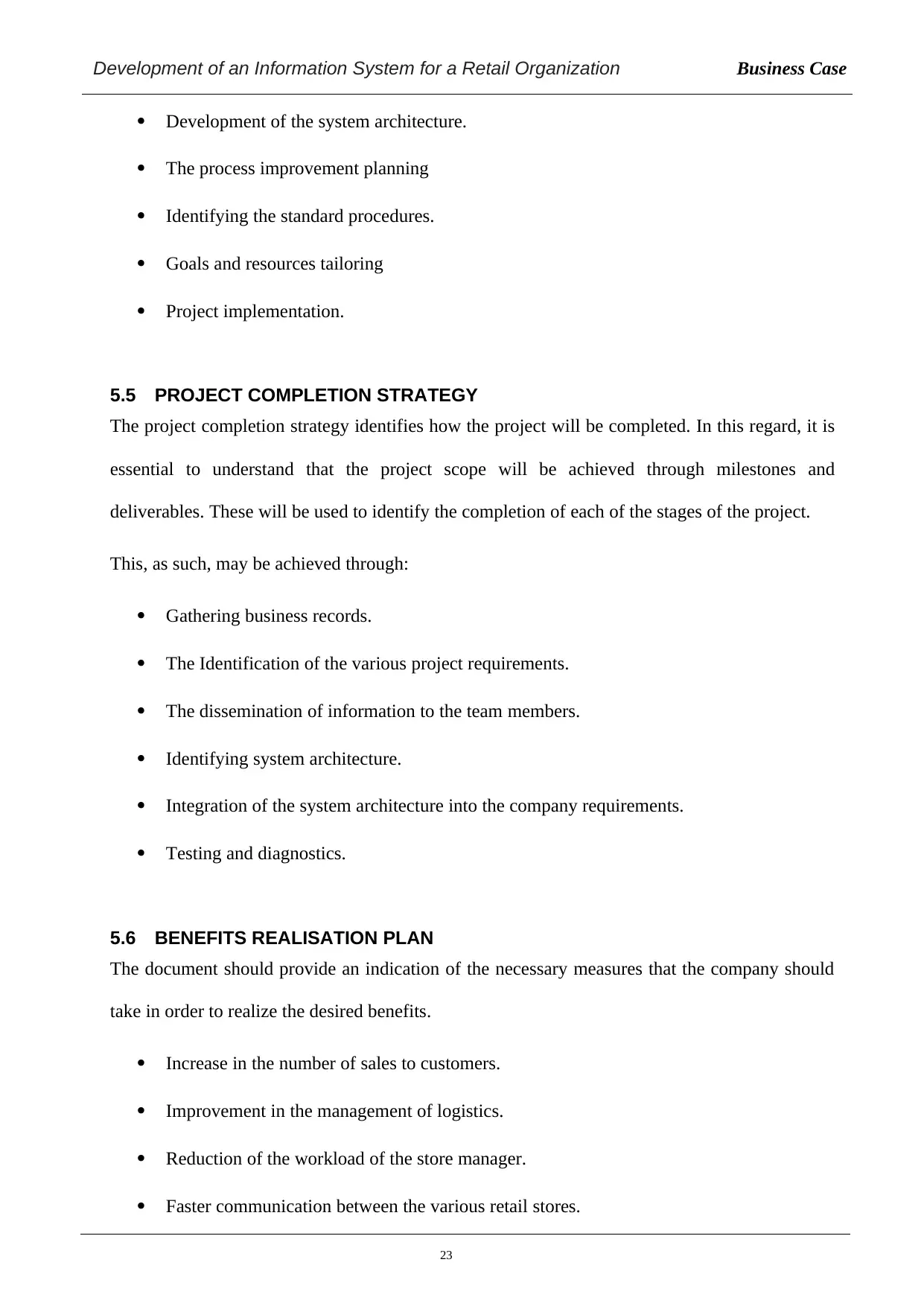
Development of an Information System for a Retail Organization Business Case
Development of the system architecture.
The process improvement planning
Identifying the standard procedures.
Goals and resources tailoring
Project implementation.
5.5 PROJECT COMPLETION STRATEGY
The project completion strategy identifies how the project will be completed. In this regard, it is
essential to understand that the project scope will be achieved through milestones and
deliverables. These will be used to identify the completion of each of the stages of the project.
This, as such, may be achieved through:
Gathering business records.
The Identification of the various project requirements.
The dissemination of information to the team members.
Identifying system architecture.
Integration of the system architecture into the company requirements.
Testing and diagnostics.
5.6 BENEFITS REALISATION PLAN
The document should provide an indication of the necessary measures that the company should
take in order to realize the desired benefits.
Increase in the number of sales to customers.
Improvement in the management of logistics.
Reduction of the workload of the store manager.
Faster communication between the various retail stores.
23
Development of the system architecture.
The process improvement planning
Identifying the standard procedures.
Goals and resources tailoring
Project implementation.
5.5 PROJECT COMPLETION STRATEGY
The project completion strategy identifies how the project will be completed. In this regard, it is
essential to understand that the project scope will be achieved through milestones and
deliverables. These will be used to identify the completion of each of the stages of the project.
This, as such, may be achieved through:
Gathering business records.
The Identification of the various project requirements.
The dissemination of information to the team members.
Identifying system architecture.
Integration of the system architecture into the company requirements.
Testing and diagnostics.
5.6 BENEFITS REALISATION PLAN
The document should provide an indication of the necessary measures that the company should
take in order to realize the desired benefits.
Increase in the number of sales to customers.
Improvement in the management of logistics.
Reduction of the workload of the store manager.
Faster communication between the various retail stores.
23
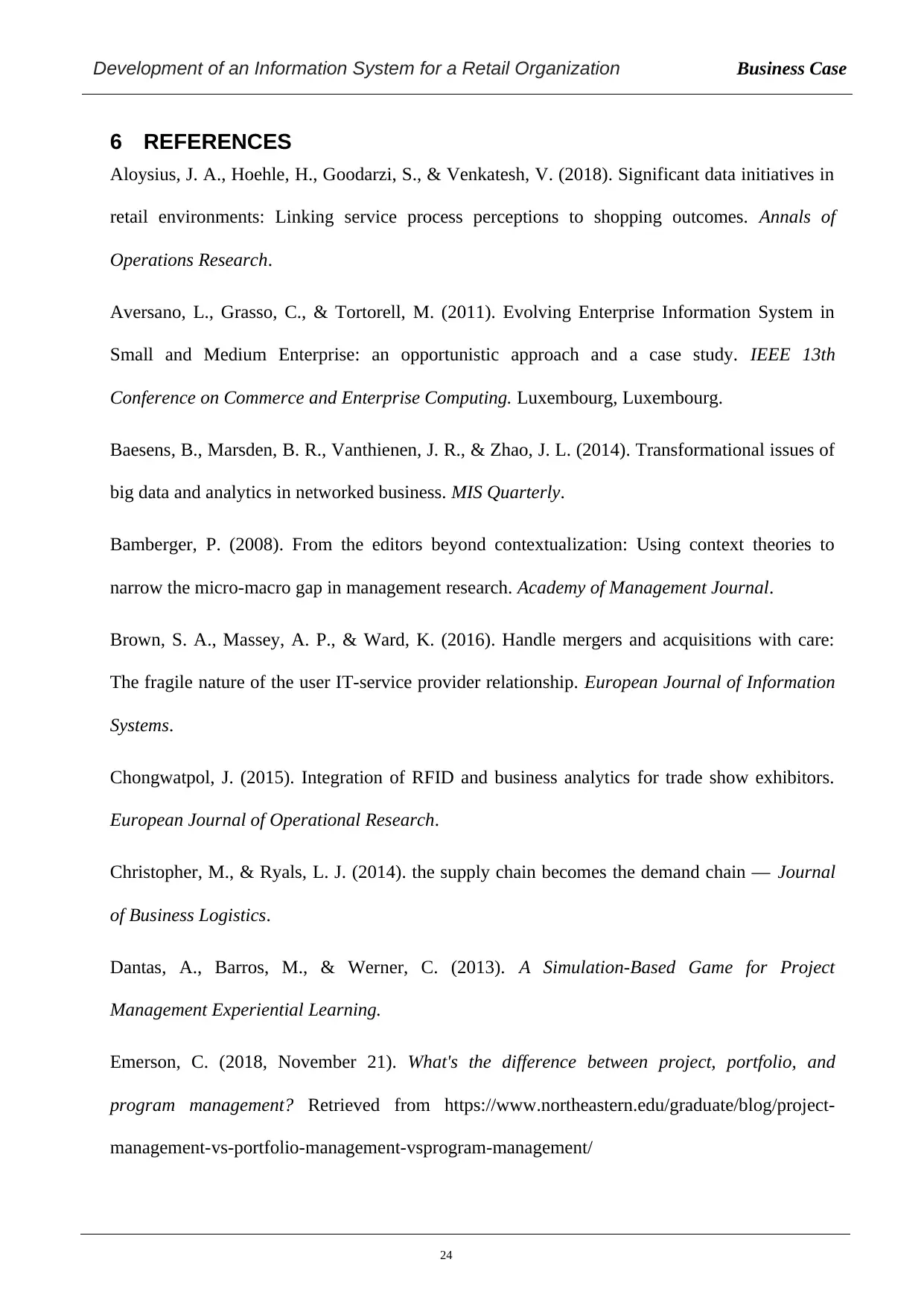
Development of an Information System for a Retail Organization Business Case
6 REFERENCES
Aloysius, J. A., Hoehle, H., Goodarzi, S., & Venkatesh, V. (2018). Significant data initiatives in
retail environments: Linking service process perceptions to shopping outcomes. Annals of
Operations Research.
Aversano, L., Grasso, C., & Tortorell, M. (2011). Evolving Enterprise Information System in
Small and Medium Enterprise: an opportunistic approach and a case study. IEEE 13th
Conference on Commerce and Enterprise Computing. Luxembourg, Luxembourg.
Baesens, B., Marsden, B. R., Vanthienen, J. R., & Zhao, J. L. (2014). Transformational issues of
big data and analytics in networked business. MIS Quarterly.
Bamberger, P. (2008). From the editors beyond contextualization: Using context theories to
narrow the micro-macro gap in management research. Academy of Management Journal.
Brown, S. A., Massey, A. P., & Ward, K. (2016). Handle mergers and acquisitions with care:
The fragile nature of the user IT-service provider relationship. European Journal of Information
Systems.
Chongwatpol, J. (2015). Integration of RFID and business analytics for trade show exhibitors.
European Journal of Operational Research.
Christopher, M., & Ryals, L. J. (2014). the supply chain becomes the demand chain — Journal
of Business Logistics.
Dantas, A., Barros, M., & Werner, C. (2013). A Simulation-Based Game for Project
Management Experiential Learning.
Emerson, C. (2018, November 21). What's the difference between project, portfolio, and
program management? Retrieved from https://www.northeastern.edu/graduate/blog/project-
management-vs-portfolio-management-vsprogram-management/
24
6 REFERENCES
Aloysius, J. A., Hoehle, H., Goodarzi, S., & Venkatesh, V. (2018). Significant data initiatives in
retail environments: Linking service process perceptions to shopping outcomes. Annals of
Operations Research.
Aversano, L., Grasso, C., & Tortorell, M. (2011). Evolving Enterprise Information System in
Small and Medium Enterprise: an opportunistic approach and a case study. IEEE 13th
Conference on Commerce and Enterprise Computing. Luxembourg, Luxembourg.
Baesens, B., Marsden, B. R., Vanthienen, J. R., & Zhao, J. L. (2014). Transformational issues of
big data and analytics in networked business. MIS Quarterly.
Bamberger, P. (2008). From the editors beyond contextualization: Using context theories to
narrow the micro-macro gap in management research. Academy of Management Journal.
Brown, S. A., Massey, A. P., & Ward, K. (2016). Handle mergers and acquisitions with care:
The fragile nature of the user IT-service provider relationship. European Journal of Information
Systems.
Chongwatpol, J. (2015). Integration of RFID and business analytics for trade show exhibitors.
European Journal of Operational Research.
Christopher, M., & Ryals, L. J. (2014). the supply chain becomes the demand chain — Journal
of Business Logistics.
Dantas, A., Barros, M., & Werner, C. (2013). A Simulation-Based Game for Project
Management Experiential Learning.
Emerson, C. (2018, November 21). What's the difference between project, portfolio, and
program management? Retrieved from https://www.northeastern.edu/graduate/blog/project-
management-vs-portfolio-management-vsprogram-management/
24

Development of an Information System for a Retail Organization Business Case
Fosso Wamba, S., Akter, S., Coltman, T., & Ngai, E. W. (2015). Guest editorial: Information
technology-enabled supply chain management. Production Planning & Control.
Giani, F. (2017, January 4). The added value of project management: The business perspective.
Retrieved from www.p3mo-team.org/EN/added-values-of-project-management-the-business-
perspective/?lang=en
Goller, B., & Hoffmann, S. (2013). Leveraging big data for precision in-store marketing:
Turning real-time data into big-time insights. Retail Property Insights.
Hansen, B. (2018, October 7). What is a program manager vs. a project manager? Retrieved
from https://www/wrike.com/blog/program-manager-vs-project-manager/
Hugos, M. H. (2018). Essentials of supply chain management.
Loosemore, M., Danity, A., & Lingard, H. (2011). Human Resources Management in
Construction Project: Strategic Operational Approaches.
Maull, R., Geraldi, J., & Johnston, R. (2012). Service supply chains: A customer perspective.
Journal of Supply Chain Management.
Moses, S. (2018, April 9). 15 Killer Projects management practices for managers. Retrieved
from https://www.workamajiq.com/blog/project-management-best-practices
Ponsen, J., & Ruijter, C. (2002). Project-oriented education: learning by doing. Proceedings of
the First CIRP International Manufacturing Education Conference. Enschede .
Rastogi, N., & Trivedi, M. K. (2016). PESTLE TECHNIQUE – A TOOL TO IDENTIFY
EXTERNAL RISKS IN CONSTRUCTION PROJECTS. International Research Journal of
Engineering and Technology, 3 (1).
Wan, Y., & Clegg, B. (2010). Enterprise management and ERP development: a case study of
Zoomlion using the dynamic enterprise reference grid. International Conference on ENTERprise
Information Systems (pp. 191-198).
25
Fosso Wamba, S., Akter, S., Coltman, T., & Ngai, E. W. (2015). Guest editorial: Information
technology-enabled supply chain management. Production Planning & Control.
Giani, F. (2017, January 4). The added value of project management: The business perspective.
Retrieved from www.p3mo-team.org/EN/added-values-of-project-management-the-business-
perspective/?lang=en
Goller, B., & Hoffmann, S. (2013). Leveraging big data for precision in-store marketing:
Turning real-time data into big-time insights. Retail Property Insights.
Hansen, B. (2018, October 7). What is a program manager vs. a project manager? Retrieved
from https://www/wrike.com/blog/program-manager-vs-project-manager/
Hugos, M. H. (2018). Essentials of supply chain management.
Loosemore, M., Danity, A., & Lingard, H. (2011). Human Resources Management in
Construction Project: Strategic Operational Approaches.
Maull, R., Geraldi, J., & Johnston, R. (2012). Service supply chains: A customer perspective.
Journal of Supply Chain Management.
Moses, S. (2018, April 9). 15 Killer Projects management practices for managers. Retrieved
from https://www.workamajiq.com/blog/project-management-best-practices
Ponsen, J., & Ruijter, C. (2002). Project-oriented education: learning by doing. Proceedings of
the First CIRP International Manufacturing Education Conference. Enschede .
Rastogi, N., & Trivedi, M. K. (2016). PESTLE TECHNIQUE – A TOOL TO IDENTIFY
EXTERNAL RISKS IN CONSTRUCTION PROJECTS. International Research Journal of
Engineering and Technology, 3 (1).
Wan, Y., & Clegg, B. (2010). Enterprise management and ERP development: a case study of
Zoomlion using the dynamic enterprise reference grid. International Conference on ENTERprise
Information Systems (pp. 191-198).
25
Paraphrase This Document
Need a fresh take? Get an instant paraphrase of this document with our AI Paraphraser

Development of an Information System for a Retail Organization Business Case
26
26

Development of an Information System for a Retail Organization Business Case
APPENDIX A
A.1 PROJECT SCHEDULE
27
APPENDIX A
A.1 PROJECT SCHEDULE
27
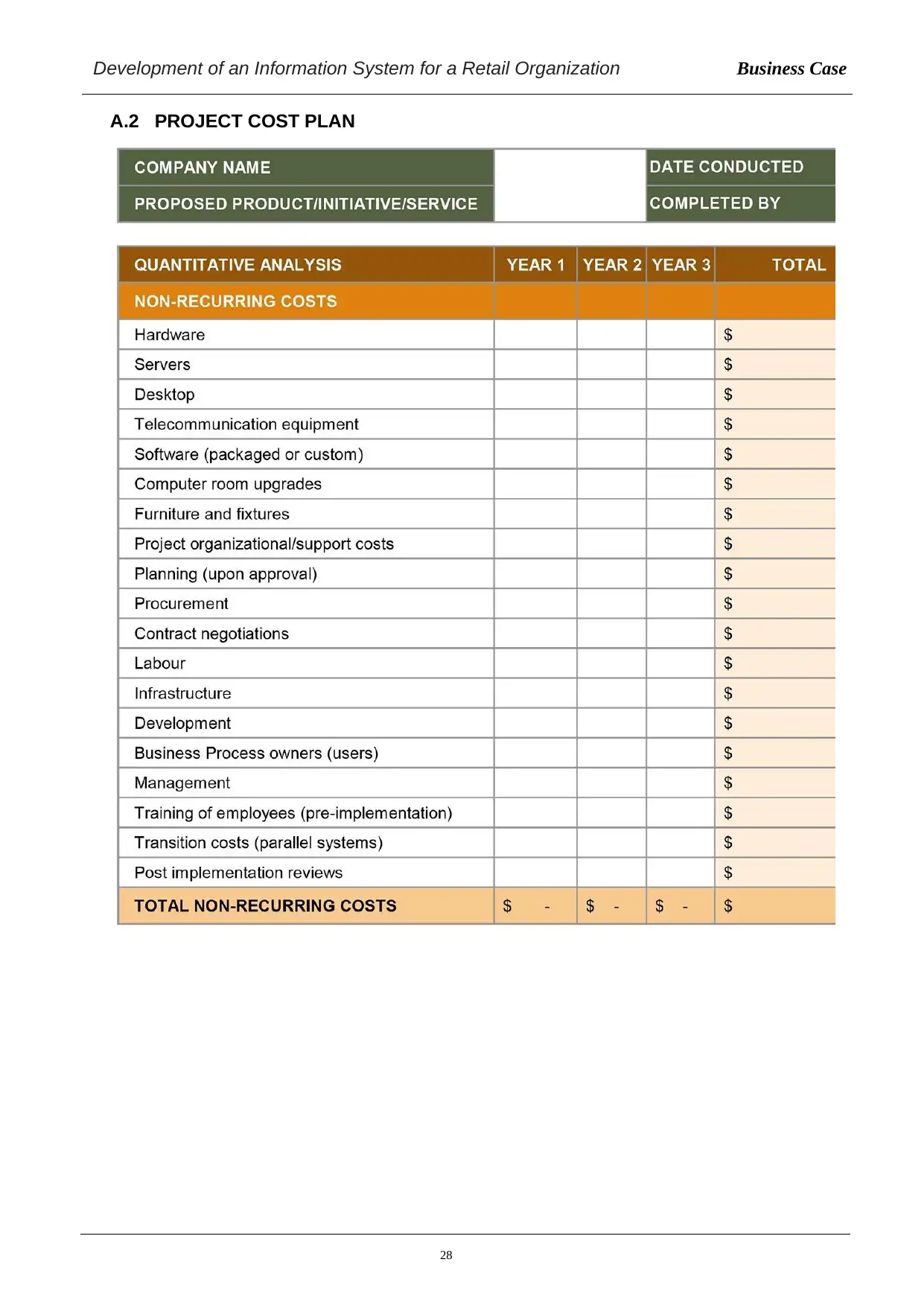
Development of an Information System for a Retail Organization Business Case
A.2 PROJECT COST PLAN
28
A.2 PROJECT COST PLAN
28
Secure Best Marks with AI Grader
Need help grading? Try our AI Grader for instant feedback on your assignments.
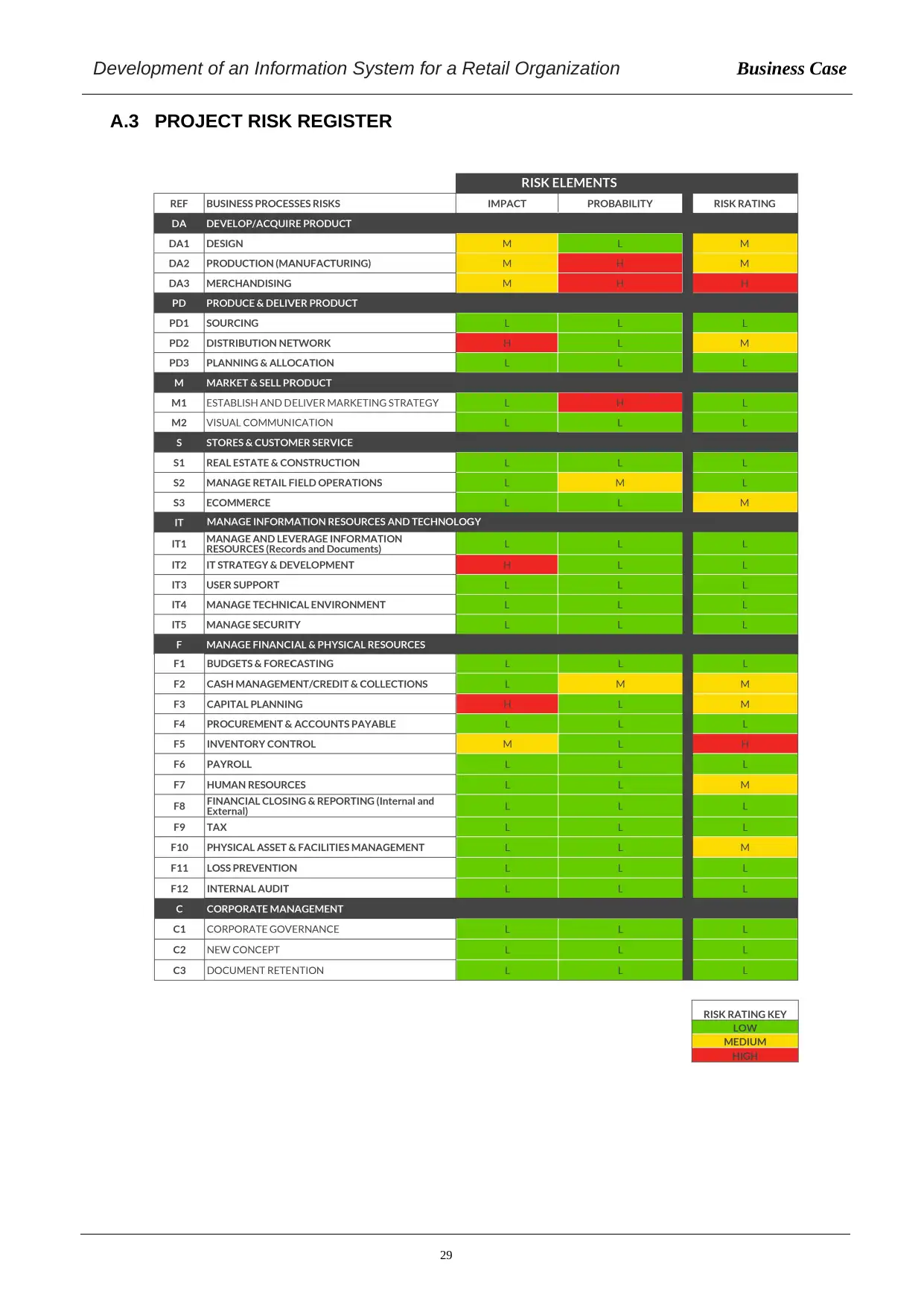
Development of an Information System for a Retail Organization Business Case
A.3 PROJECT RISK REGISTER
29
A.3 PROJECT RISK REGISTER
29
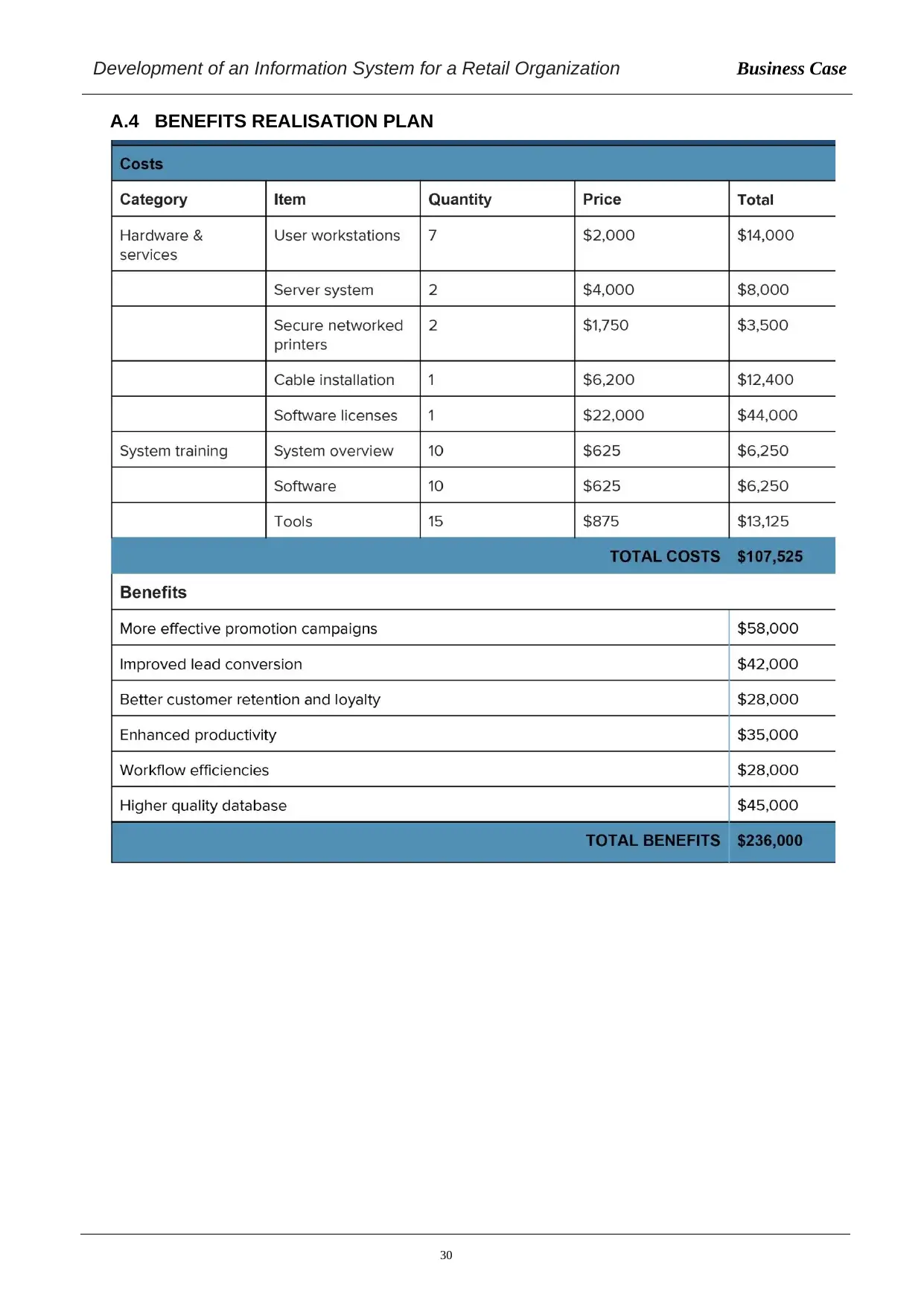
Development of an Information System for a Retail Organization Business Case
A.4 BENEFITS REALISATION PLAN
30
A.4 BENEFITS REALISATION PLAN
30

Development of an Information System for a Retail Organization Business Case
A.5 FINANCIAL ANALYSIS on OPTIONS
31
A.5 FINANCIAL ANALYSIS on OPTIONS
31
Paraphrase This Document
Need a fresh take? Get an instant paraphrase of this document with our AI Paraphraser

Development of an Information System for a Retail Organization Business Case
A.6 STAKEHOLDER ASSESSMENT MATRIX
32
A.6 STAKEHOLDER ASSESSMENT MATRIX
32
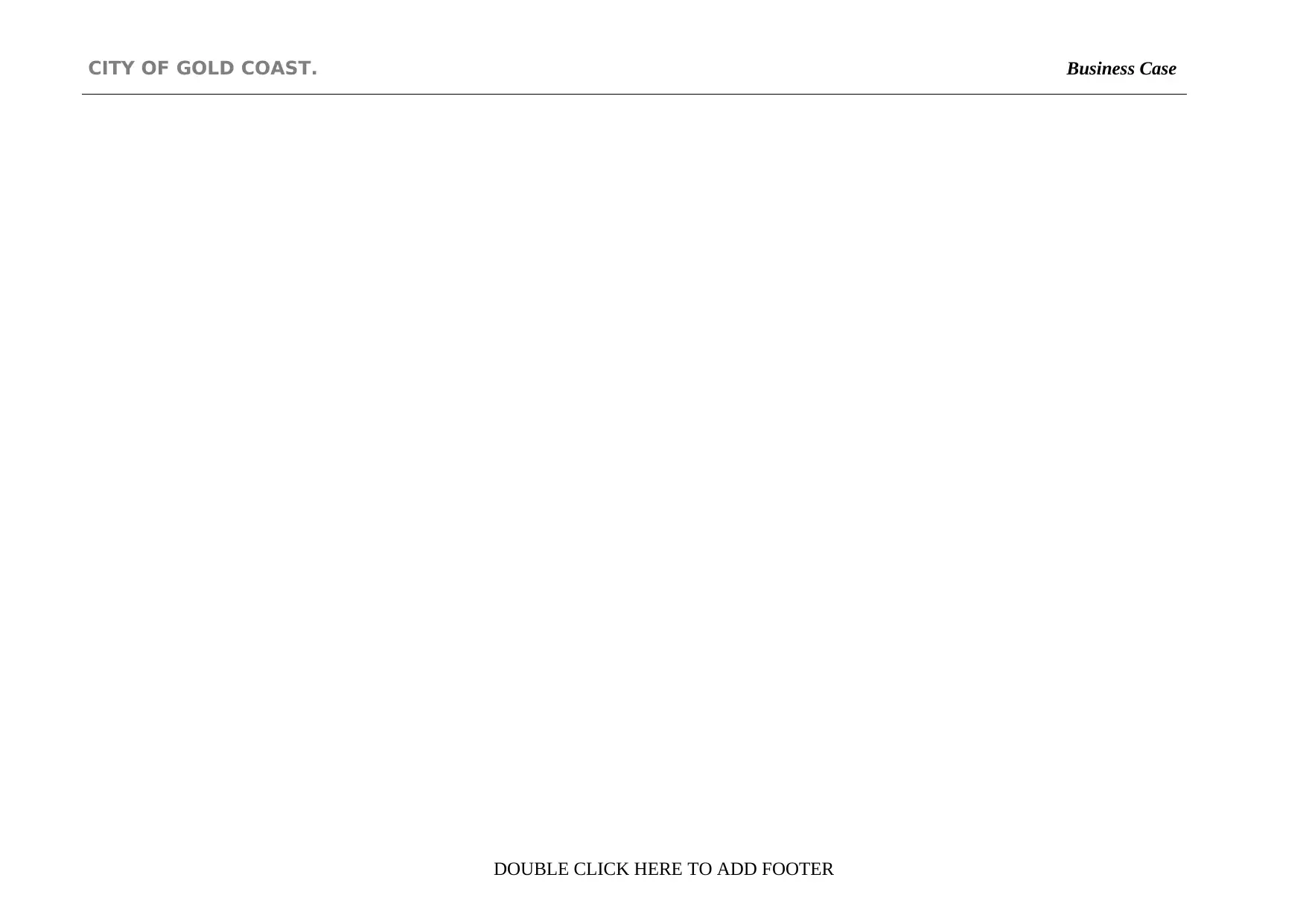
CITY OF GOLD COAST. Business Case
DOUBLE CLICK HERE TO ADD FOOTER
DOUBLE CLICK HERE TO ADD FOOTER
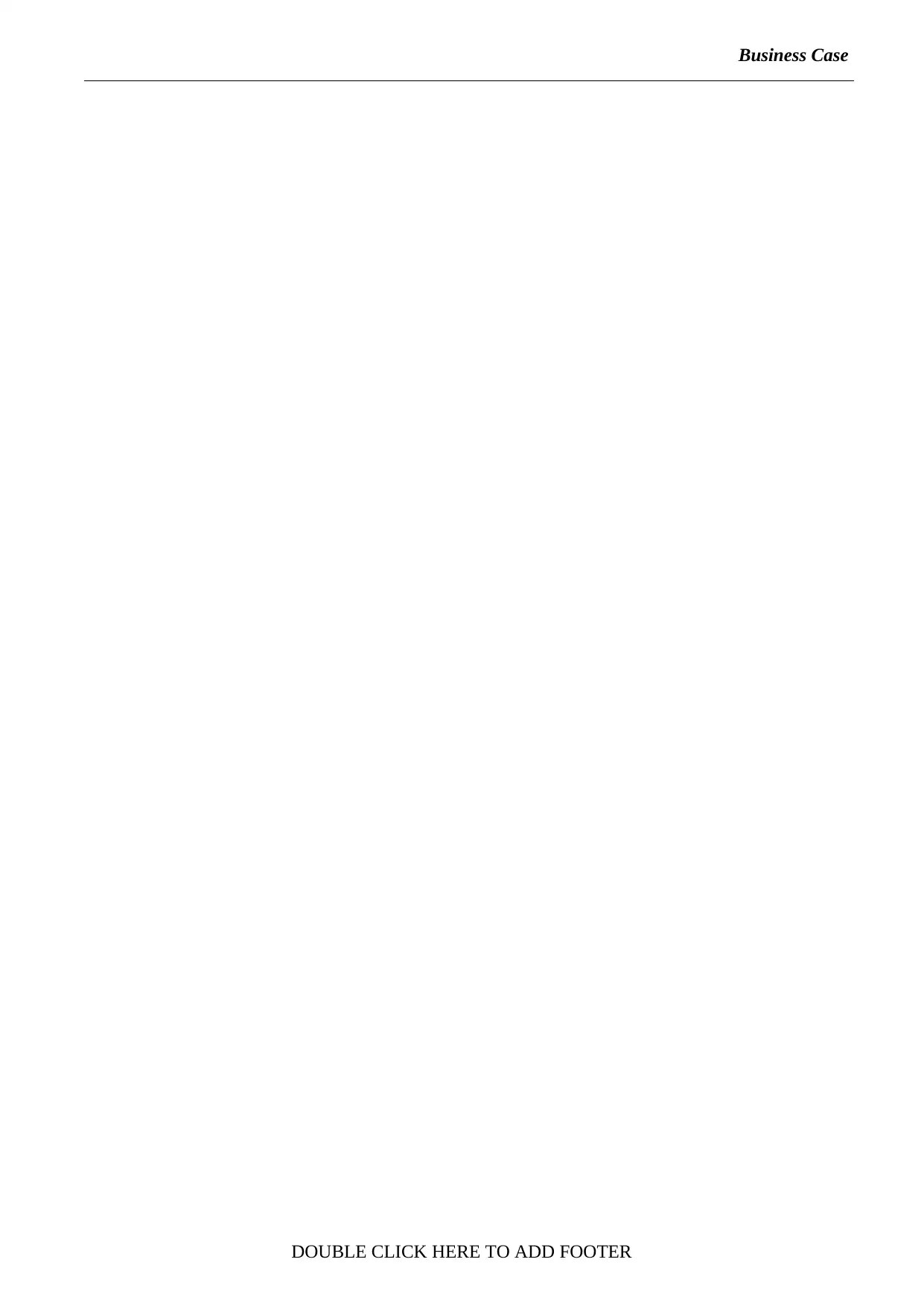
Business Case
DOUBLE CLICK HERE TO ADD FOOTER
DOUBLE CLICK HERE TO ADD FOOTER
1 out of 34
![[object Object]](/_next/static/media/star-bottom.7253800d.svg)





